Mission Day 11: Orbicella faveolata, where art thou?
Published 8.5.16
A 4 hour tour…a 4 hour tour.
Once we completed our training Extravehicular Activity (EVA) dives for 1 and 2 hours a piece, it was time to complete a full 4 hour EVA. Megan and I were the first team up on Mission Day 11.
After we suited up, completed safety, staged out from the habitat and weighted ourselves out for partial gravity, we picked up the pre-stages sled packed with presampling tools, including the PAM fluorometer, temporary tags, the iDive iPad for identification and cue cards that the crew can use for information, and a tool kit stuff with smaller EVA tools. One of us is also carrying a Shark Marine navigator to guide us to the target site.
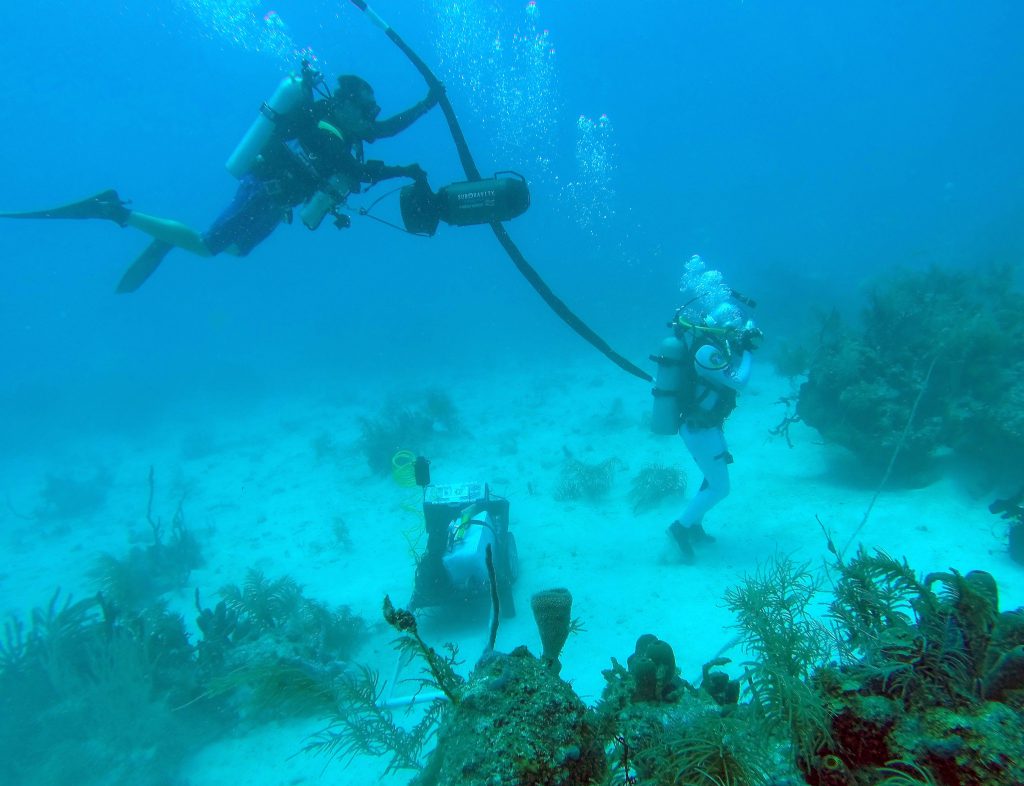
The goal: look for three specific types of coral in one of the ‘deep’ zones, ranging 80-95 FSW in depth. Pulling out sled behind us, we walked down the sandy slopes, past instruments and towering structures left from missions past, turned into artificial reef systems around the habitat. One of the most important things we have to pay attention to on our dives are where our umbilicals are in the water.
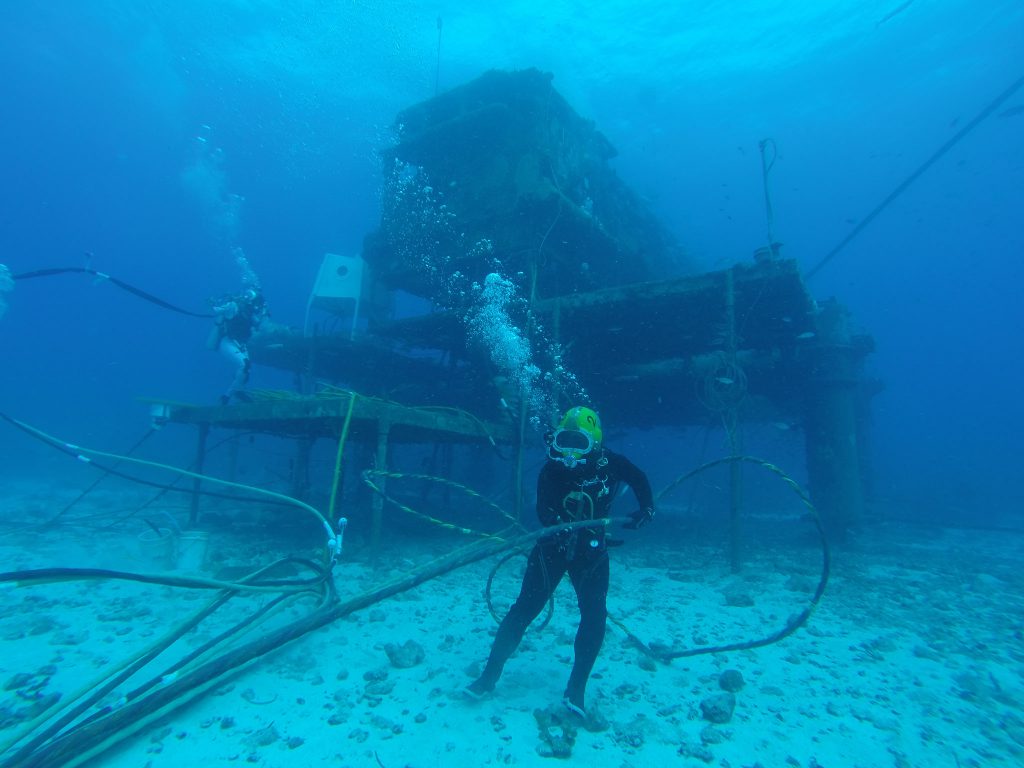
For this mission, we had up to 600 feet of umbilical, which include our air supply, comms, and pneumometer for gauging depth, running back to the habitat that we could work with, which can be an absolute snake best if not properly managed! We had to keep them from wrapping around coral, ourselves, and each other. THANKFULLY, our hard hat safety diver and one of the Aquarius Reef Base habitat technicians, Sean Moore, helped us manage them out to a certain point. After that, we had support divers in the water with Subgravity scooters keeping an eye on where the umbilicals ran as we went deeper. As I mentioned before, it definitely takes an experienced and hard-working village to do these missions safely!
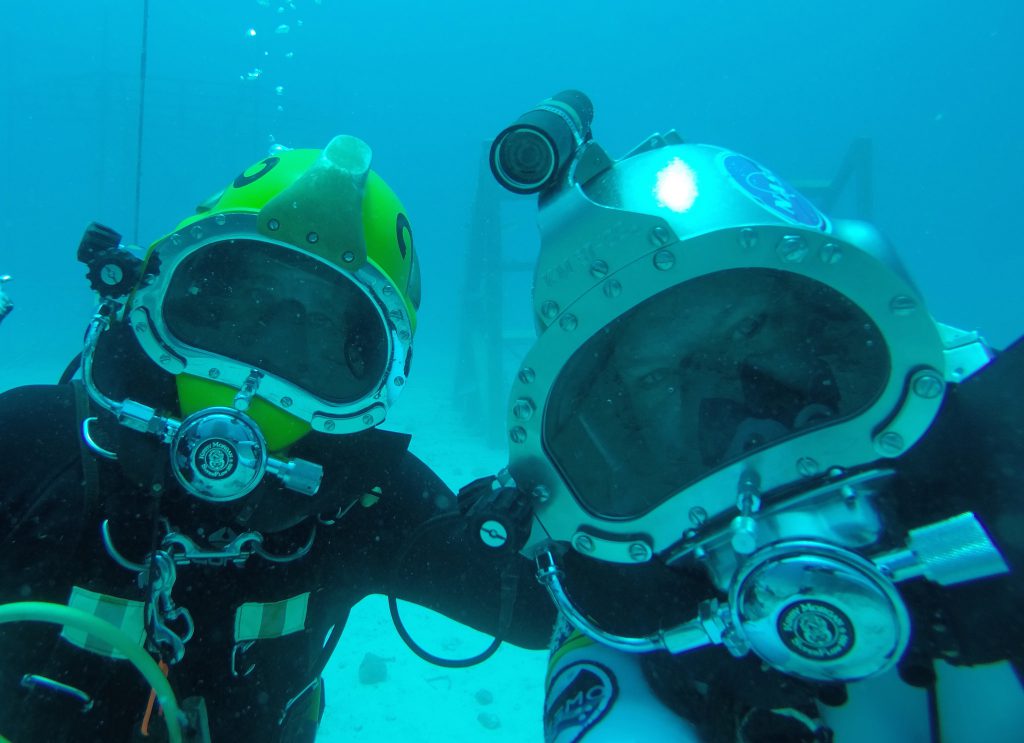
The traverse to the deep reef takes approximately 5 minutes, then we set the sled in a secure location and get to work searching for Orbicella faveolata, Agaricites humilis, and Agaricites agaricia. While some coral species were very easy to locate, others are not as prevalent in certain designated zones or depth ranges. We searched until we ran out of temporary tags, identifying 22 species for potential sampling! For each tagged coral, we then take photos and PAM readings for the science team to review. We read all of this information back to IV (the person running the show from inside the habitat), which is then relayed back to the science team via time-delayed messages and a data sheet. They will give feedback for our next EVA in which of the species they want us to sample. Ultimately, these procedures are all being evaluated as NASA moves towards planetary exploration missions, where boots on the ground will need to be able to relay science and exploration back to the appropriate support teams and Mission Control for decision making and data management.
When we wrapped up the presampling phase, we picked up the sled and walked back up the sandy slope towards the habitat, cutting left to the Mercury coral tree nursery that was built in collaboration with the Coral Restoration Foundation during the first half of the mission. We collected PAM readings from the samples there before heading back to the habitat, with the IV and Science Team calling it a successful day!
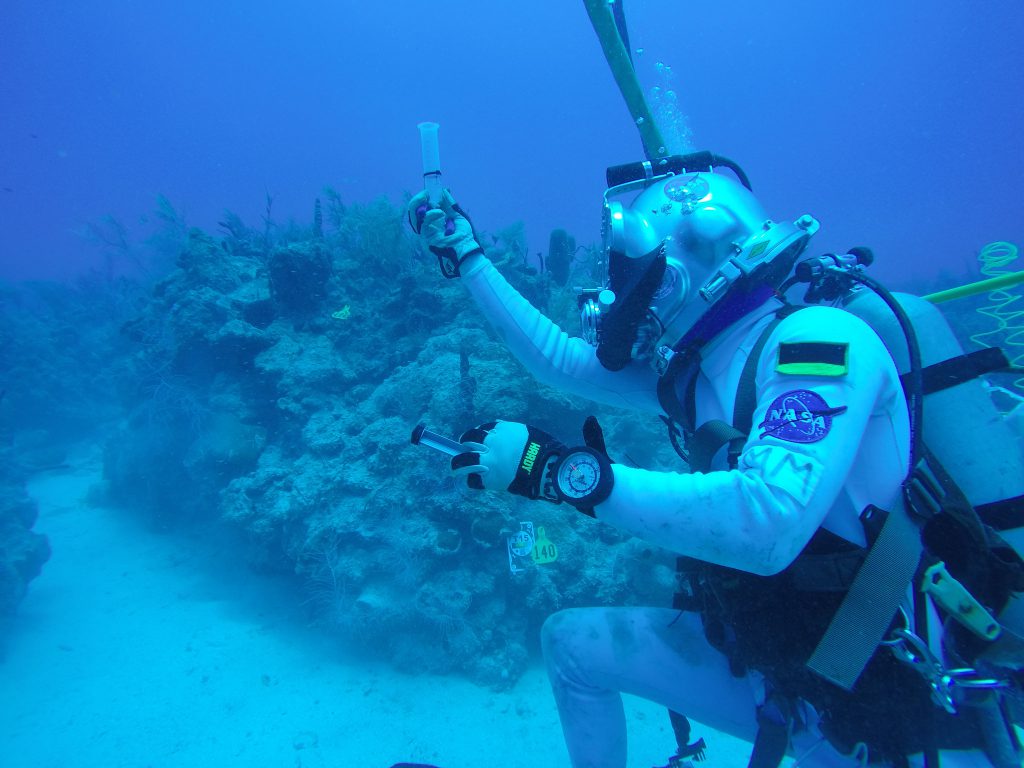
Compared to regular SCUBA, the hard hat system is amazing because of the real-time comms and continuous gas supply. The partial gravity weighting, plus the weight of the helmet, require strength and stamina throughout the dive – by the end of the executions, we can all definitely feel the physical and mental fatigue setting in – and a craving for pizza starts to kick in, too! IV is continuously asking us to rate our discomfort and perceived exertion (on a predefined scale) for feedback to Mission Control and as part of a study being conducted by NASA.
On Mission Day 12, I get to run IV communication – a little nervous while very excited to give it a go! Details to follow in be MD 12 blog!
Mission Days 9-10: Settling in Undersea
Published 8.1.16
Noel and I splashed down on Friday (Mission Day 9) morning, and 24 hours later we were in full saturation and joined the rest of our crew as official Aquanauts! Before we submerged from the topside world, we had the chance to see Reid and Marc as they splashed up – they gave us a round of hugs and some friendly words of advice before we left the surface 🙂 Marc will continue to work with NEEMO as topside support through the end of the mission. The crew can’t say enough wonderful things about Reid and Marc as teammates, and Reid did an amazing job commanding the first half of the mission.
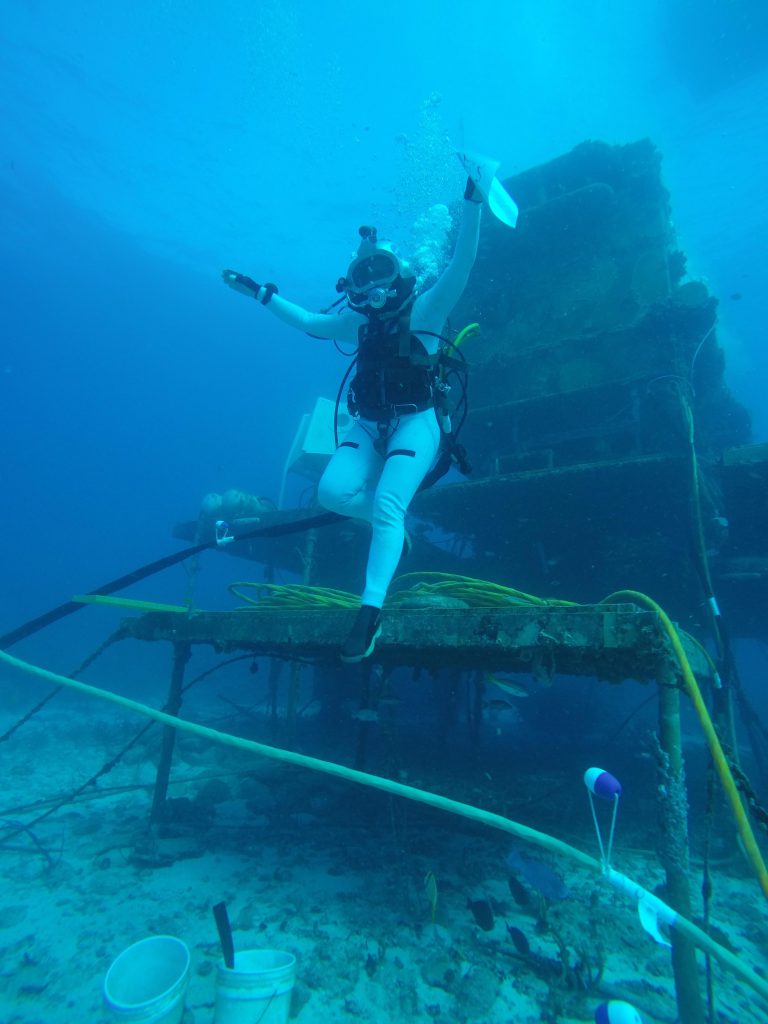
For Noel and I, after SCUBA diving down to the habitat, we entered the ‘moon pool’, which is where we enter and exit the habitat every time we dive. As soon as you get out of the water, you have to shower because we don’t want salt water all over the inside of our new home. We towered off and received a safety briefing from Hank, plus a tour of the living space and a heads up on where the good snacks are hidden 🙂 Noel and I were thoughtfully greeted with a welcome note and two homemade cookies, baked by Megan weeks earlier and frozen to be sent down throughout the mission. Megan and Matthias were out for a shorter 2 hour working dive, but they still found a way to make us feel right at home!
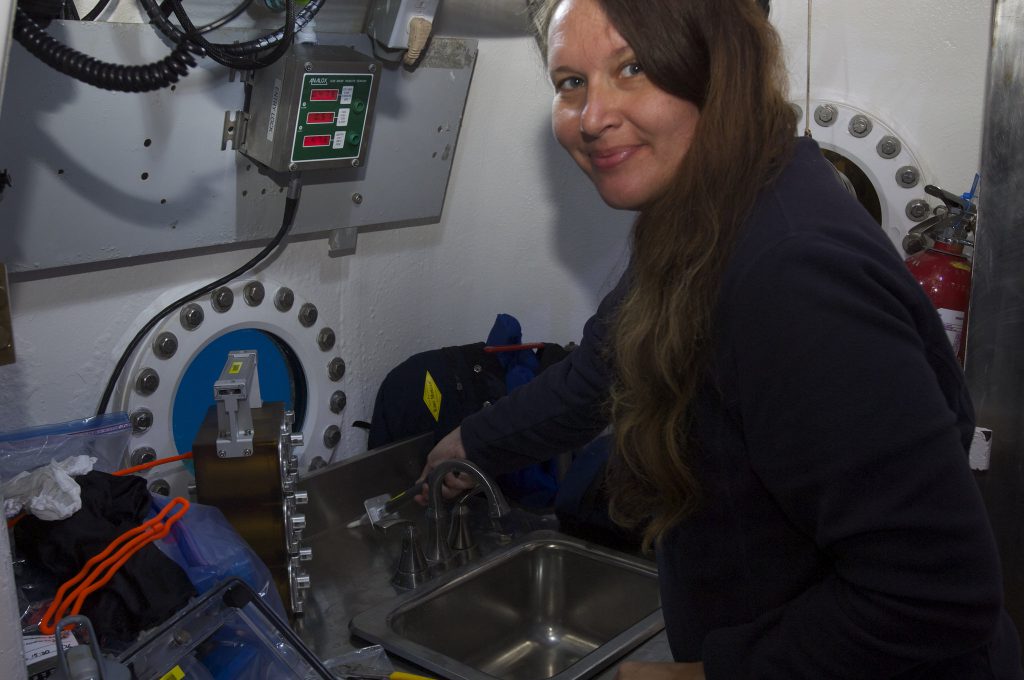
After unpacking and settling in, Noel and I did our first hard hat dive from the habitat. Hank helped us suit up and hatted each of us. We have comms both to the habitat and back to Roger at Aquarius Reef Base on land, keeping us safe and the operation running smoothly! We run safety checks both out of and in the water before leaving for the dive.
Sliding out feet first, we drop to the NASA deck to be checked out for leaks and make sure the gear looks good, then we hop off of the deck onto the sandy bottom, just a little deeper than 60 feet. We add extra weights to make sure we can comfortably work on the bottom and to simulate microgravity….then we are off for the dive!
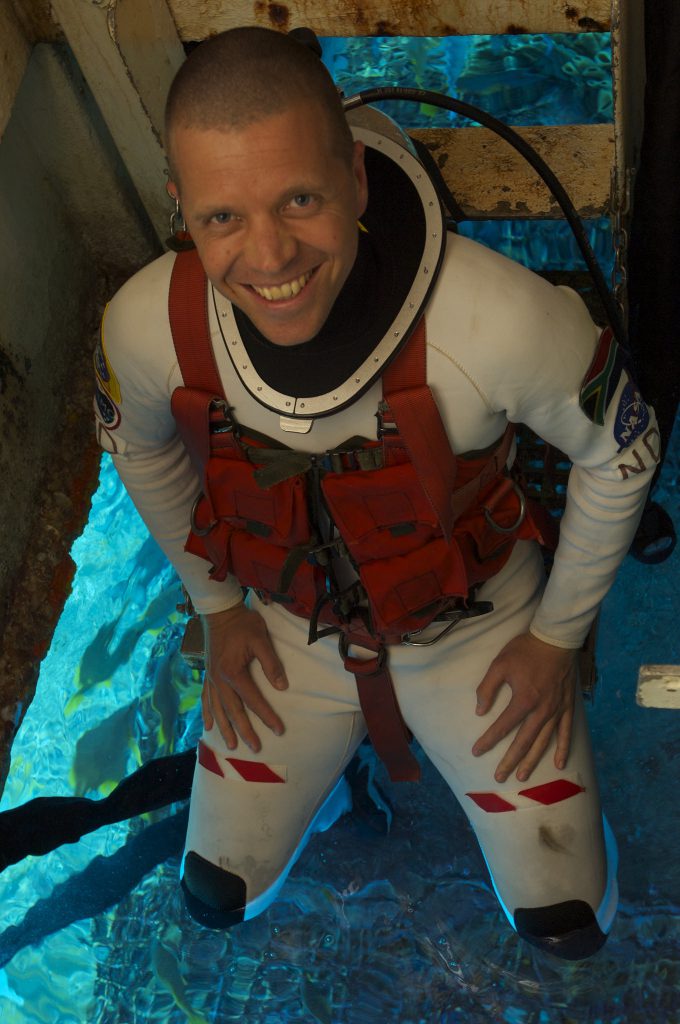
Our first night underwater was spectacular as we watched the surrounding ecosystem switch to nightshift! We also tried our hand at cooking Mountain House camp food, which is a main staple in the hab since you can cook it with hot water alone.
Mission Day 10 was my first working dive with Megan – we conducted sampling on previously identified coral for 2 hours. Getting into the work we had been trained to do was such an awesome feeling, and the time absolutely flies by underwater! Matthias and Noel also did a 2 hour EVA, packed on either side with numerous science and operational objectives. It was a hectic day and we were all happy to crawl into our bunks by the end of the evening!
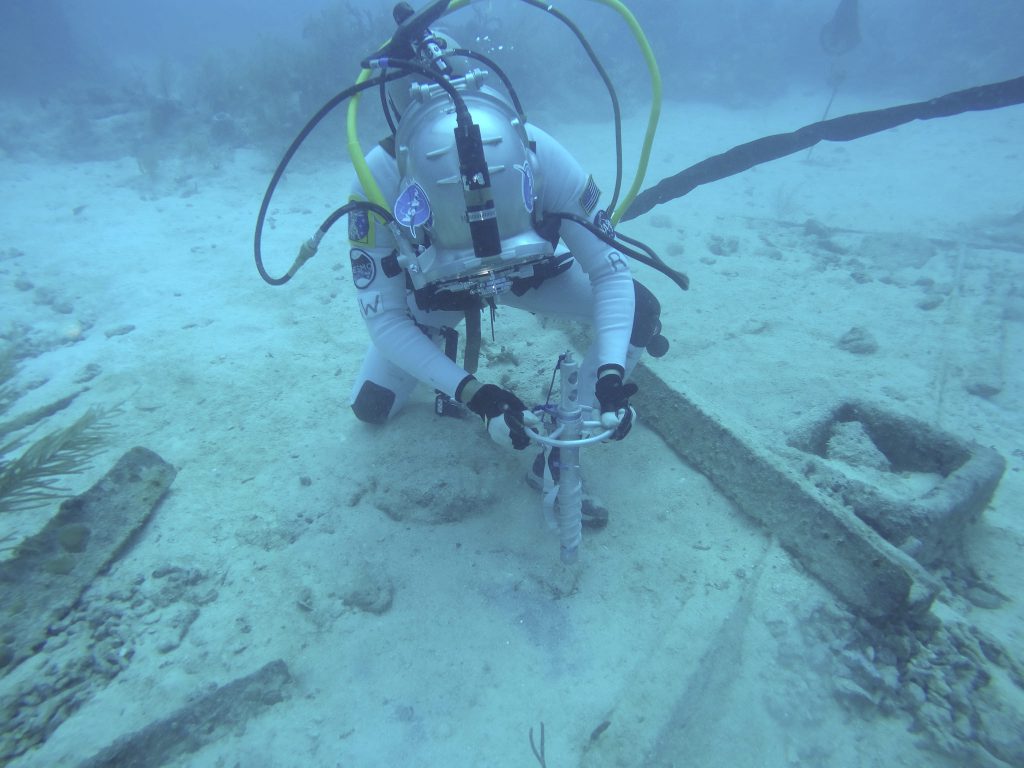
Tomorrow, Mission Day 11, Megan and I do our first 4 hour EVA!
Mission Day 7-8: Remembering Where We Are
Published 7.28.16
As we prepare for the mid-mission crew switch, we will keep this blog sweet and to-the-point.
Amidst the many EVAs, science objectives, and high operational tempo, one thing to remember at the end of the day is what we are doing – from support divers to aquanauts – is working in an environment that is potentially unforgiving if we lose our situational awareness.
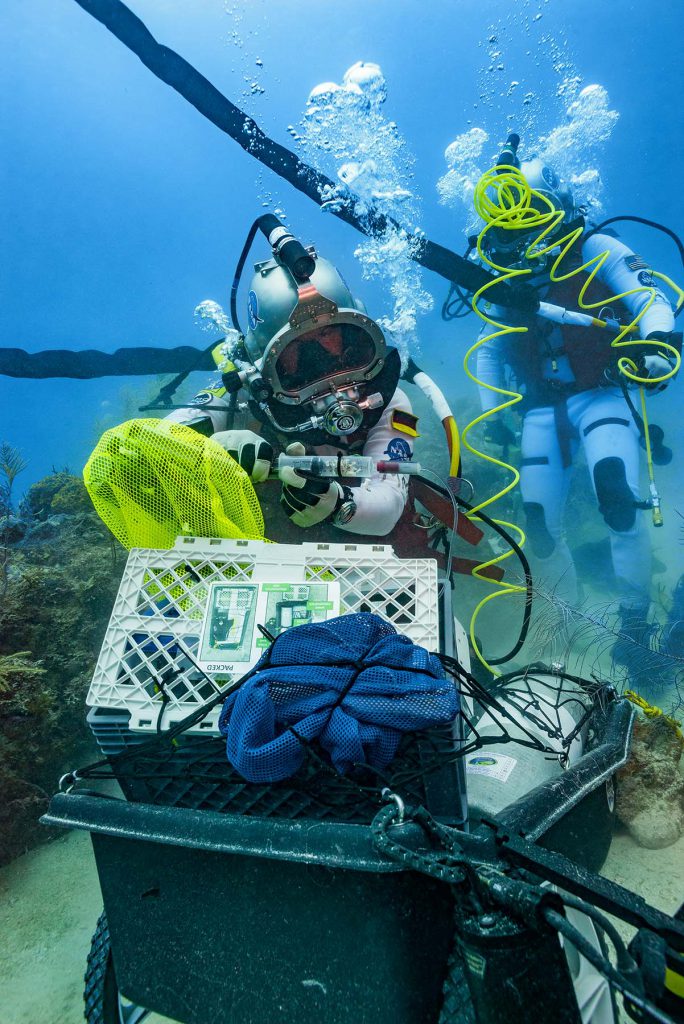
As Reid wraps up his stay in the habitat, handing over the Commander position to Megan Behnken for the second half of the mission, he sends a very clear-cut reminder of what a mission like NEEMO 21 (or any mission in an extreme environment) is about:
“Last night, after dinner, the crew was winding down from a long day of research ops. We had the habitat external lights on and it was attracting quite a spectacular show outside. Spirits of the crew were way up, adrenaline was flowing. Someone turned on the song Holy Diver and cranked the volume. We all started singing and laughing. Hank, a 30 year veteran Navy Master diver and our lead Hab Tech, walked over, turned the volume down a good bit, and said something to the effect of: don’t stop, but also don’t forget where we are.
It was perfection in motion from a man who thoroughly understands group dynamics and life in unforgiving environments. His act was quick, the feedback was clear, and we all moved on with enjoying the evening. I will walk away from NEEMO 21 with a vast amount of gained knowledge and incredible experience, but Hank’s single action of turning down the volume will be my favorite moment of the expedition.
It has been an honor to spend nine days underwater on Aquarius. The crew is exceptional- tight knit, smart, thoughtful, funny. The mission control/science team is motivated and they keep us pushing forward. The FIU/ARB team keeps us and our gear safe and in perfect order.
The first steps in exploring Mars. It is time to put people on the red planet. Fly NASA.” – NEEMO 21 Commander Reid Wiseman
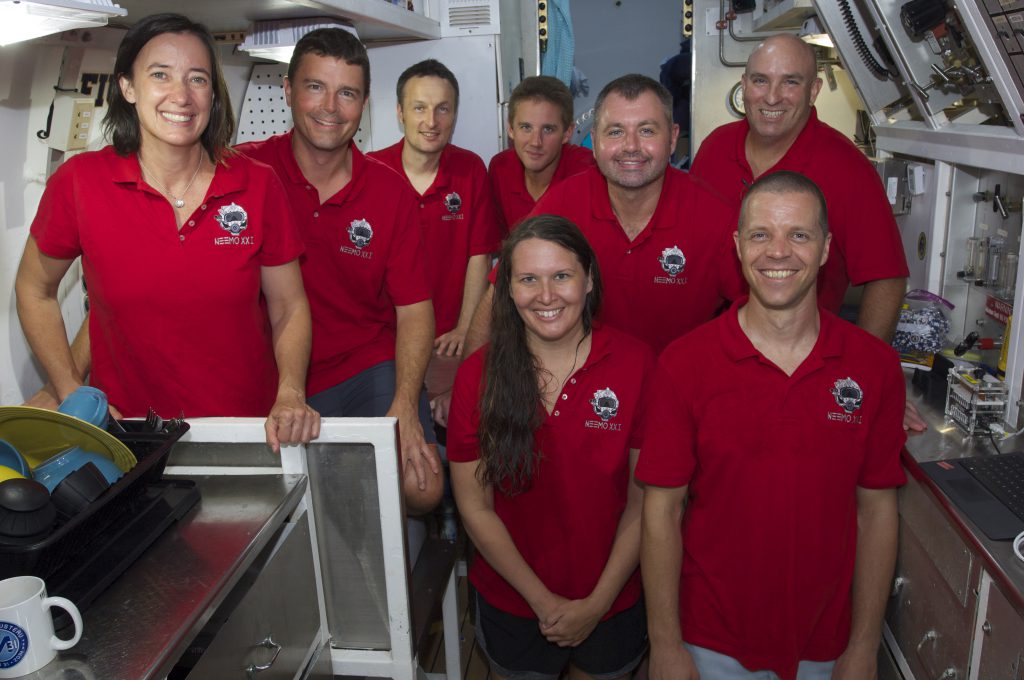
Mission Day 6: Home is Where the Heart Is
Published 7.27.16
To launch the Mission Day 6 update, Commander Reid Wiseman sent us his perspective from beneath the waves:
“Today kicked off our Mars analog which meant a 15 minute delay was synthetically added to all of our communications between the aquanauts and mission control. Building off protocols utilized in NEEMO20 last year, we were able to execute true scientific coral exploration and sample gathering with unexpected efficiency. It was a great validation of proposed techniques. Here’s the recap:
Last night, we received tasking from our science team that they wanted us to focus on two coral reefs for our excursion today- one considered a shallow reef at 55-60 feet and the other a deep reef at 85-90 feet. Due to the long delay in communication and to test some new scheduling tools, the science team only gave us general areas to explore and let us build the entire plan. Outside the habitat wearing the Kirby Morgan dive helmets we had myself and Matthias for a four hour excursion. Inside the habitat, running the entire plan via radio communication, was Megan with Marc assisting. Megan also had a text messaging system with synthetic time delay to both mission control and the science team. This text system called ‘Playbook’ was crucial to our success.
At both locations we were looking specifically for Orbicella and Agaricia. Needless to say, Matthias and I studied quite a bit last night so we could find the targeted species today. As I left the habitat, I had quite a fright when I literally stumbled across a Southern Stingray buried in the sand on the sea floor. Watching that ray unmask and fly off was absolutely gorgeous.”
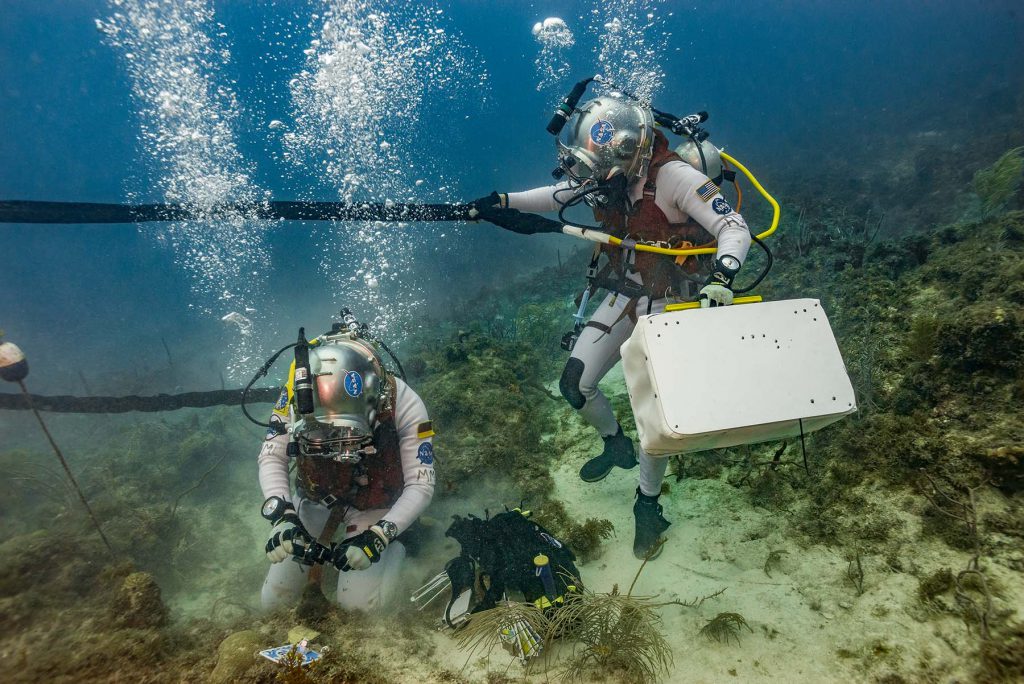
Matthias and Reid working as a team to identify coral and collect PAM data
“At the shallow reef, Matthias and I placed temporary markers and used helmet cameras to highlight areas of suspected Agaricia and Orbicella. Agaricia was easy to find…Orbicella, not so much. Our imagery and tagging was tracked by Megan INSIDE beamed to the science team for their analysis. After about 45 minutes at the shallow reef, Matthias and I headed deeper to explore the 90 foot reef. We did this mainly to give the science team time to analyze our shallow reef imagery and confirm which coral they wanted sampled. Since we had a 30 minute round-trip comm delay, they had to work fast. And they did.
As Matthias and I approached the deep reef, we experienced one of the weirdest sensations of my life – instantly the current picked up four to five times its strength and dropped roughly 20 degrees. We went from warm to shivering in minutes. Pieces of sea floor plant life were littered throughout the water column and floating by. Even the water looked different, almost appeared rippled or spotty. It was clear a storm or some other phenomena was rolling through. Once we adjusted to our new climate, we got to quick work identifying the plentiful Agaricia. Orbicella at that depth was sparse, but we did find two nice looking samples. Matthias also found a beautiful Moray Eel peeking out of the reef. Due to the time delay, we didn’t sample at the deep reef. Tonight, the science team will evaluate our imagery and direct Megan and Marc what to sample when they go out tomorrow morning.”
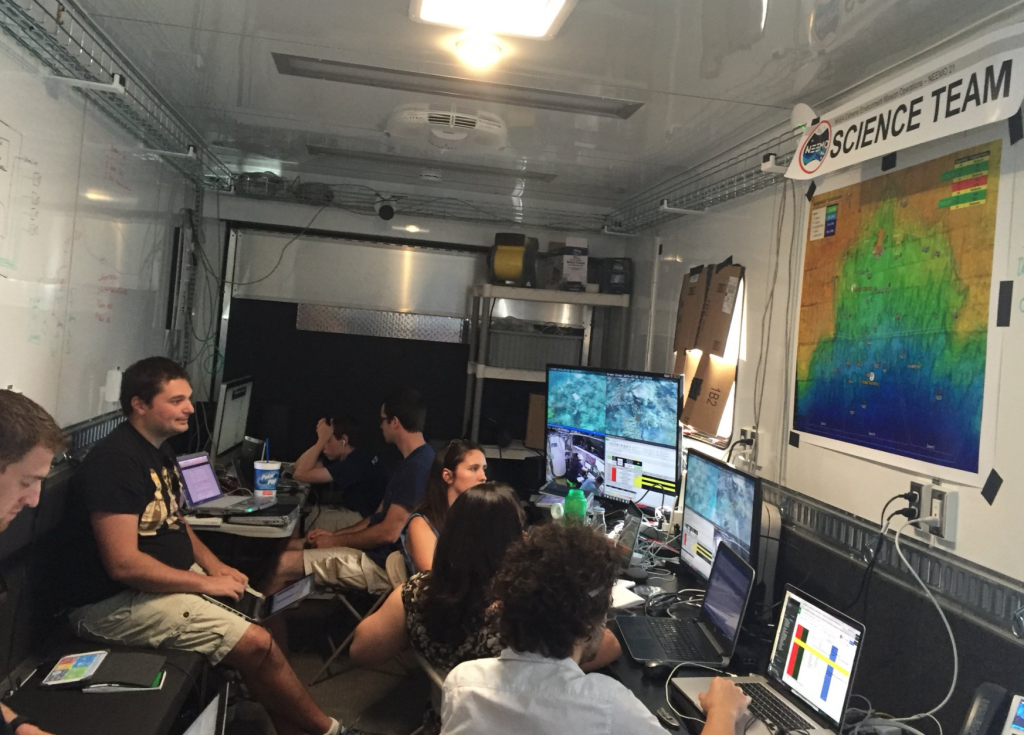
FIU Images Marine Science Team monitoring the coral exploration and sampling by the crew on EVA
“After an hour deep, we headed back to the shallow reef and saw a good sized Nurse Shark on the journey. The science team had plenty of work for us and relayed their tasking via Playbook to Megan. As we set up shop at the shallow reef, Megan was happy to report that we had found three Orbicellas, four Agaricia, and three other corals that were not correctly identified. Hey, seven out of ten… I’ll take that! The scientists directed Megan to have us perform drill samples of the three Orbicella and diagonal cuts of the Agaricia. That process took us about an hour and was easier than expected. It never feels good drilling into coral but we have permits to take no more than 10% of a colony to study its health and genetic diversity at various depths.
Upon completion of the shallow reef sampling, Matthias and I packed up and returned to the habitat. Everyone was motivated and excited at the efficiency and success of our first full day of Mars analog. It went great. Learning abound, but overall it was far better than expected. After doffing the helmets, Marc handed Matthias and I warm mugs of Barry’s Irish tea and it was exactly what the doctor ordered.”
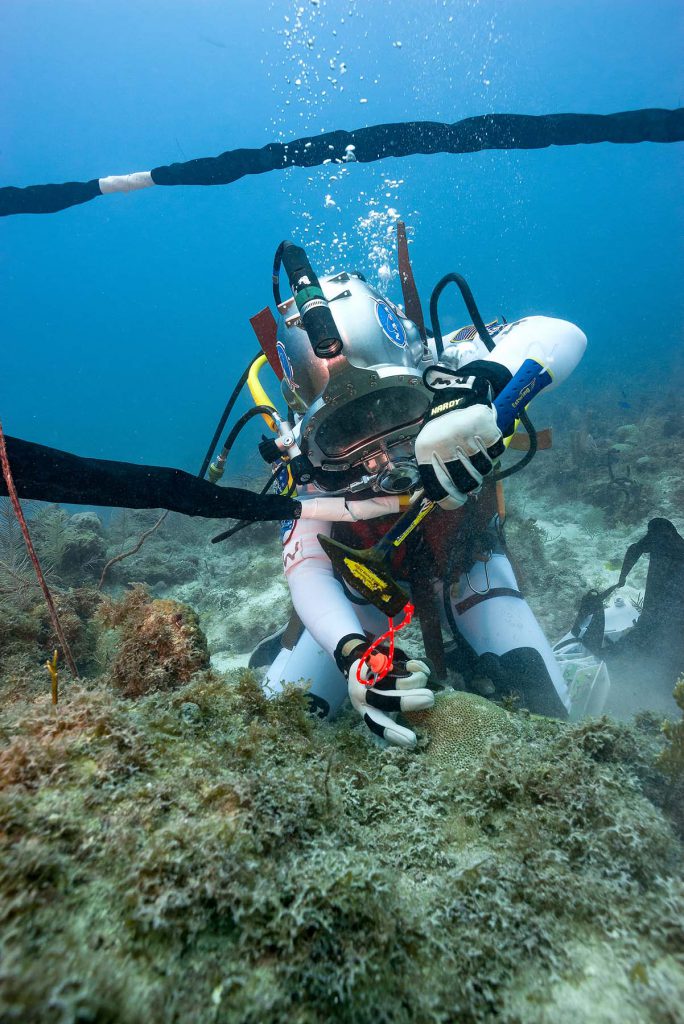
Tagging identified coral for future data collection and sampling
Above the waves, the topside support teams continue to work around the clock (literally!) to ensure the safety and efficiency of the mission. Our Featured NEEMO 21 Team of the Day are the men and women from Aquarius Reef Base, our home for the duration of the mission, who make these missions possible year-round for a variety of expeditionary, scientific, and operational test teams.
Featured NEEMO 21 Team of the Day: The Aquarius Reef Base (ARB) Crew
The ARB crew make the mission run, plain and simple. Crew and staff training, boat operations and dive equipment maintenance, and everything that has to do with the habitat operations is in the hands of the very experienced, very knowledgeable, very hard-working ARB staff.
Program Director Tom Potts and Operations Director Roger Garcia run the overall show, with decades of combined Navy and NOAA diving experience between the two of them. Along those same lines of extensive military and scientific diving experience, Science Manager Otto Rutten, and Operations Managers Mark “Otter” Hulsbeck and Hank Stark make daily operational decisions while also doing field-based work as boat captains, diving supervisors, and habitat technicians. Otter has actually spent well over 200 days in saturation in the Aquarius habitat – each member of the ARB leadership are dedicated to the missions that come through Aquarius, literally living and breathing their work!
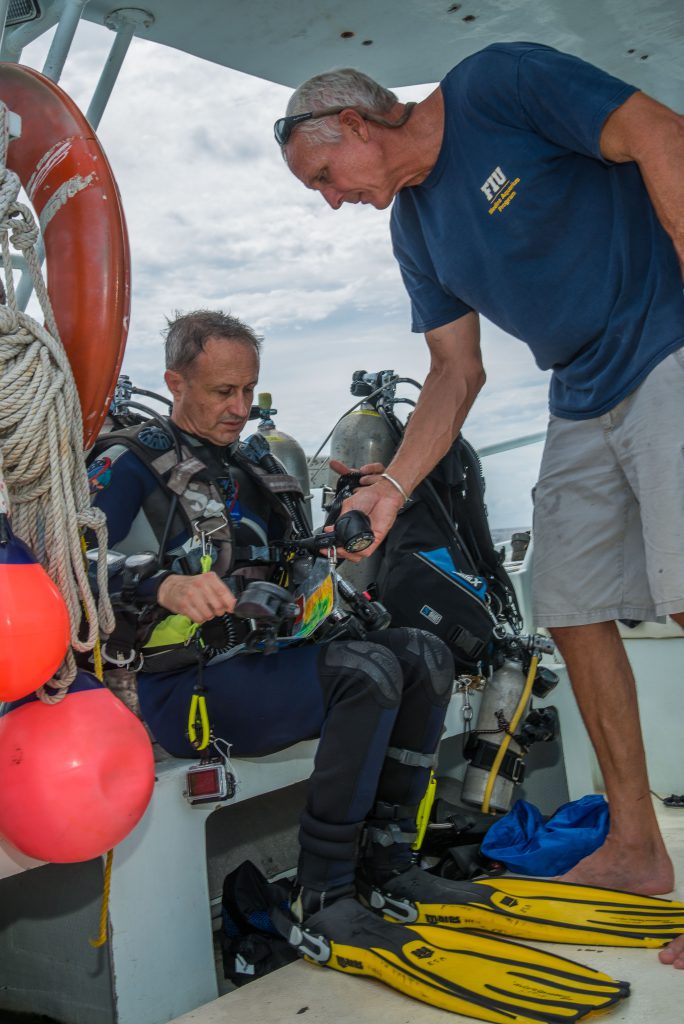
Otto Rutten prepares Herve’ Stevenin for a support dive on Aquarius
Sean Moore is also a habitat technician and Dive Specialist, with a Navy diving background as a Rescue Swimmer. He and Hank are the habitat technicians living with the crew and keeping us safe and sound during NEEMO 21! Tom Horn is the Research Programs Specialist and is also a Dive Specialist, with a background in technical and cave diving (and an East Carolina Alumni, which was sparred fun jabs since I am an North Carolina State alum!) Ivana Sanchez is also a Dive Specialist, with a background in environmental science, and Liz McNamee is FIU’s Assistant Dive Officer and Boating Safety Officer. On a daily basis, we see Tom, Ivana, and Liz working incredibly hard on the boats and around the base! Promoting responsible stewardship and teaching sustainable use of the natural environment, Aileen Soto is Director of Education and Outreach for ARB.
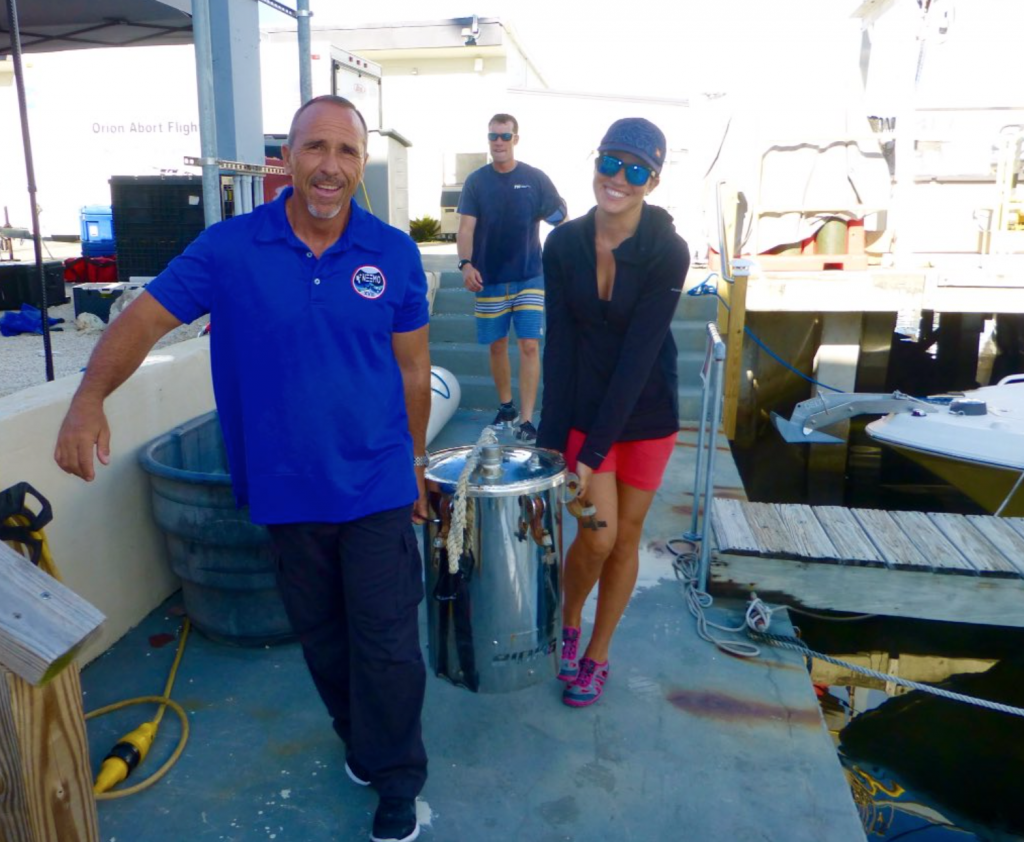
Roger Garcia, Ivana Sanchez, and Tom Horn loading pots filled with supplies heading to the habitat
Not only do the ARB staff dedicate themselves to what they do and do it all exceptionally well, but they are all fantastic people to be around. To just sit and hear their stories from diving and other past pursuits is enough to fill a series of books! I know I can speak for the other crew members (and entire NEEMO team) when I say we are grateful for their professionalism and tough work ethic that makes our days safe, efficient, and a lot of fun!
For more details on the ARB staff and their impressive backgrounds and list of accomplishments: https://aquarius.fiu.edu/contacts/
Mission Day 5: Tales from the Topside
Published 7.26.16
Every morning, 7:30AM at Aquarius Reef Base, the dive support, research, and operations team members meet for ‘Tag-Up’ so we can review the planned objectives for the day and voice any additional information or questions to the entire NEEMO 21 team. To see the majority of the people involved with the mission, standing in a room-wide circle, is pretty impressive and reminds us of the many layers that go into making a mission successful and productive.
After the morning team meeting on Mission Day 5, a group of us scheduled as morning dive support loaded our gear onto the George F. Bond Aquarius Reef Base dive boat. In addition to our dive equipment, the science and EVA team brought two tool sleds packed with tools for the EVA crew’s 4-hour excursion. We then buddied up and reviewed our dive plan for the morning as we headed out to the habitat.
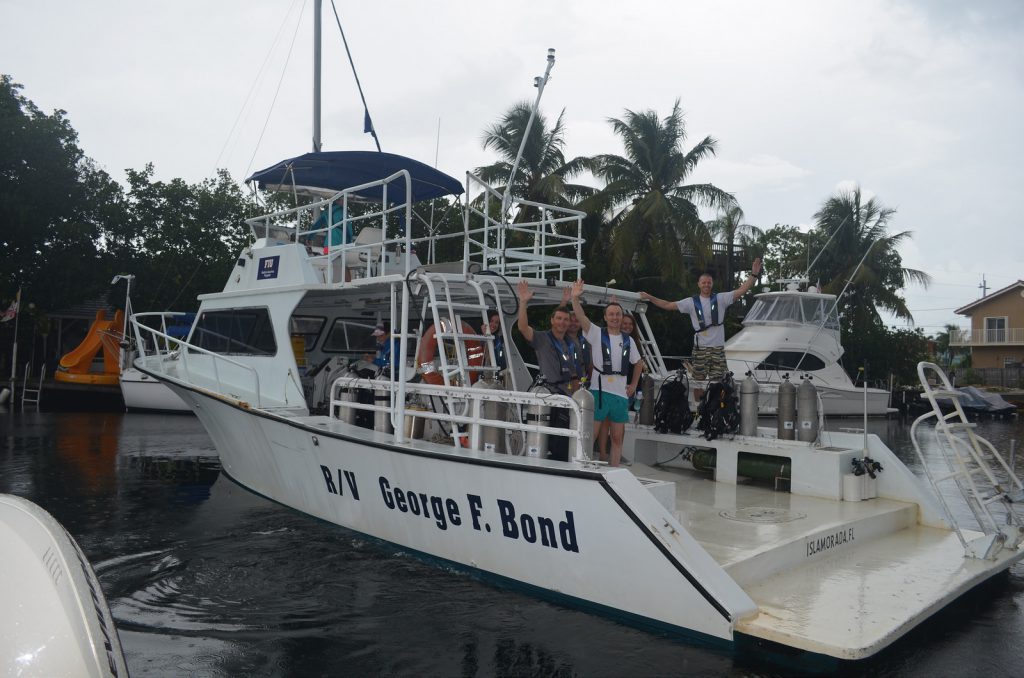
One of the ARB dive boats, aptly named after the father of saturation diving, George Bond
Dave Coan (NEEMO 20 crew member) and I were the first in the water, suiting up with a single tank of Nitrox and a bailout bottle for backup. We were tasked with carrying one of the loaded sleds down to the staging site just outside of the habitat, along with a few extra pieces of equipment for the crew. That sled is heavy until you get it to the bottom, but we crafted and executed a successful plan to get the sled down successfully – fist bumps all around!
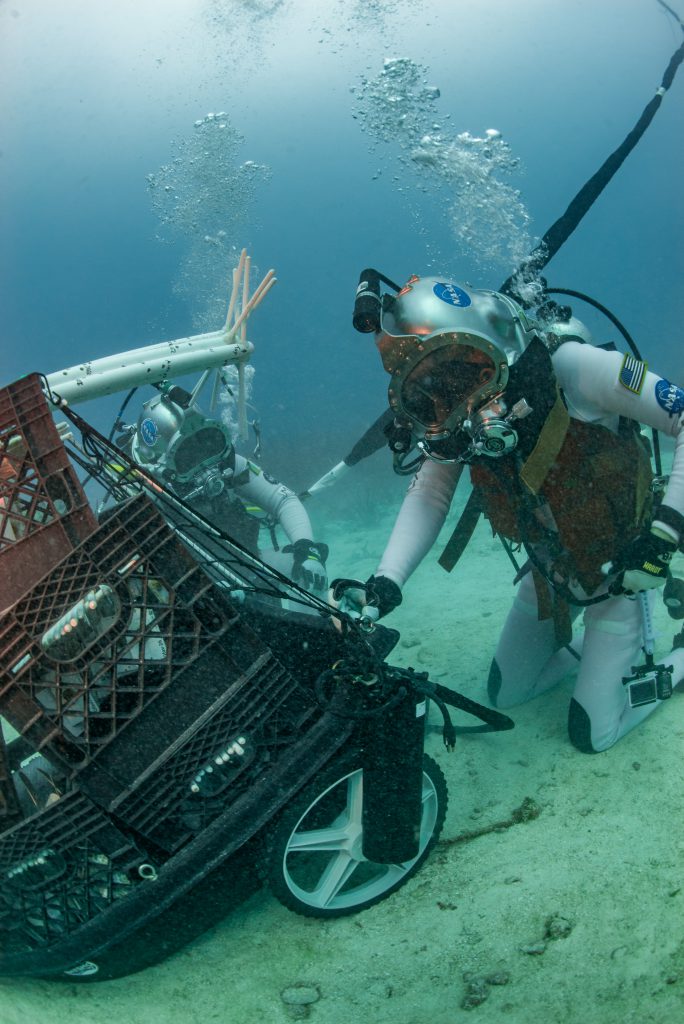
Two other support teams (Tim Broderick and Steve Chappell, Jason Poffenberger and Adam Naids) rotated throughout the dive support role, all of us doing 2 dives each. It was a great opportunity to get perspective from the topside dive support before going into the habitat. These guys work incredibly hard on their dives making sure the EVA operations run smoothly and supplies get to/from the habitat as needed!
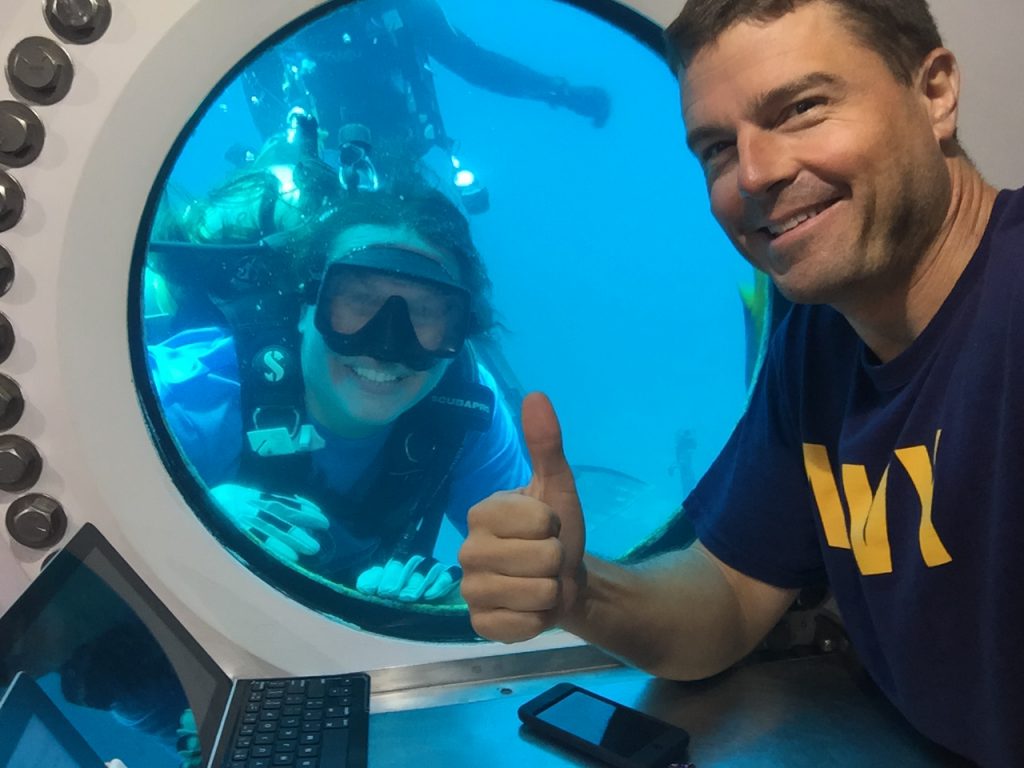
Dawn stops by the habitat to say hello to Reid at the end of her support dive
For the saturation crew, Day 5’s EVA team (Marc and Megan) worked on coral sampling and identification throughout a 4-hour excursion. Inside of the habitat, the crew continued to knock out their objectives throughout the jam-packed day. To make an exciting mission even moreso, Mission Day 5 was also the start of communication delays! In addition to simulated operations of a Martian gravity field using partial-gravity weighting during the dive, the crew and Mission Control are now dealing with time-delays associated with the vast distances between Earth and Mars (15 minutes each-way). The mission is testing methods for designing EVA timelines to be efficient and effective but still allow science team interaction, as well the communication capabilities between Mars and Earth, such as voice, video, still imagery, and text. These delays will be a part of the each day throughout the rest of mission!
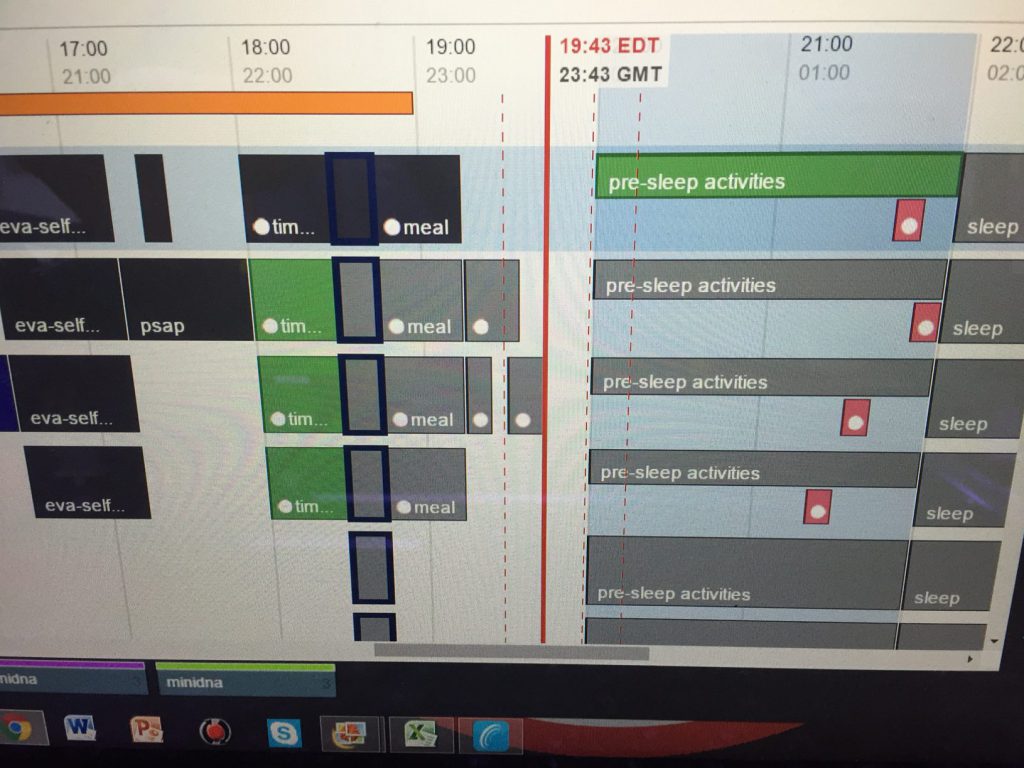
15 minute communications delays started on Mission Day 5, denoted by the dashed red lines versus the real-time solid red line
Featured NEEMO 21 Team of the Day: DNA Sequencing Undersea
One of the science objectives that each of the team members has been assigned to is sequencing swabbed sample DNA in situ, with the NEEMO 21 crew being the first to sequence DNA undersea! In parallel with the NEEMO crew’s swab-to-sequence efforts, NASA astronaut and molecular biologist Kate Rubins will soon be sequencing prepared samples in space to test the feasibility and quality of the same procedures and technology.
Enabling the identification of microorganisms and the diagnosis of infectious disease, monitoring cellular changes in response to spaceflight, informing medical interventions, and possibly detecting nucleic acid-based life elsewhere in the universe – does the Star Trek Tricorder finally exist? Not exactly, but one exceptionally small device that fits within the palm of your hand, a DNA sequencer, holds the exciting potential to do all of this! Determining the sequence of DNA is a powerful way to identify organisms and determine how they are responding to changes in the environment.
The Biomolecule Sequencer Payload ( http://www.nasa.gov/mission_pages/station/research/experiments/2181.html ) is being tested on the ISS in 2016. However, DNA samples prepared on the ground will be used in this proof-of-concept investigation to demonstrate that DNA sequencing in the microgravity environment of space is possible.
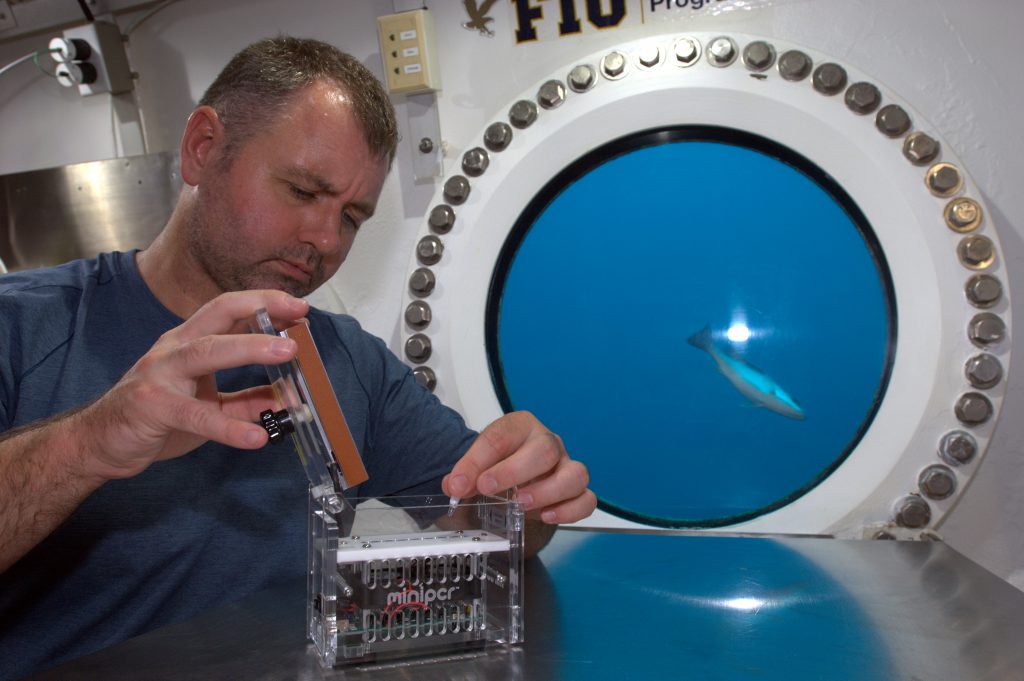
Dr. Marc O Griofa sets up samples for PCR amplification
The ability to perform on-orbit sample collection and the manipulations required to generate sequence-ready DNA is not yet reality, but the protocol has been developed and will be tested on NEEMO 21. The crew, using a spaceflight-compatible process, will collect a swab sample from the Aquarius habitat, extract the DNA, amplify and modify that DNA, and, finally, collect the DNA sequences using the Biomolecule Sequencer. Successful implementation of the end-to-end, swab-to-sequencer process by the multi-national NEEMO crew, along with their feedback, will enable the forward development of the sample preparation process to be flight certified, allowing the Biomolecule Sequencer to be utilized to its fullest extent on the ISS. The ability to sequence more than ground-prepared samples on the ISS will not only enable crew health initiatives, but will open the doors to far wider research potential in human exploration and planetary science.
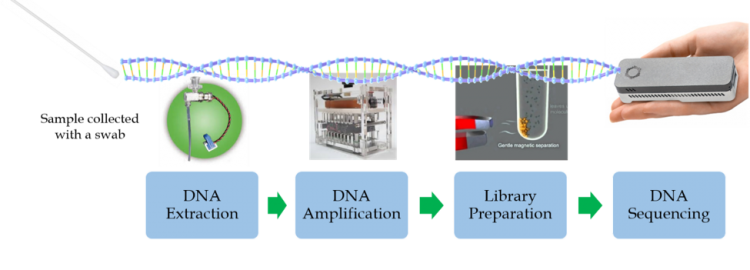
The crew has been very excited to work through the protocol developed by study PI Dr. Sarah Wallace and overseen by Sarah Stahl, especially when we see successful DNA sequencing!
Stay tuned for the Mission Day 6 update on how the adapting to comm delay and a little more about the guys who truly run the show at Aquarius Reef Base.
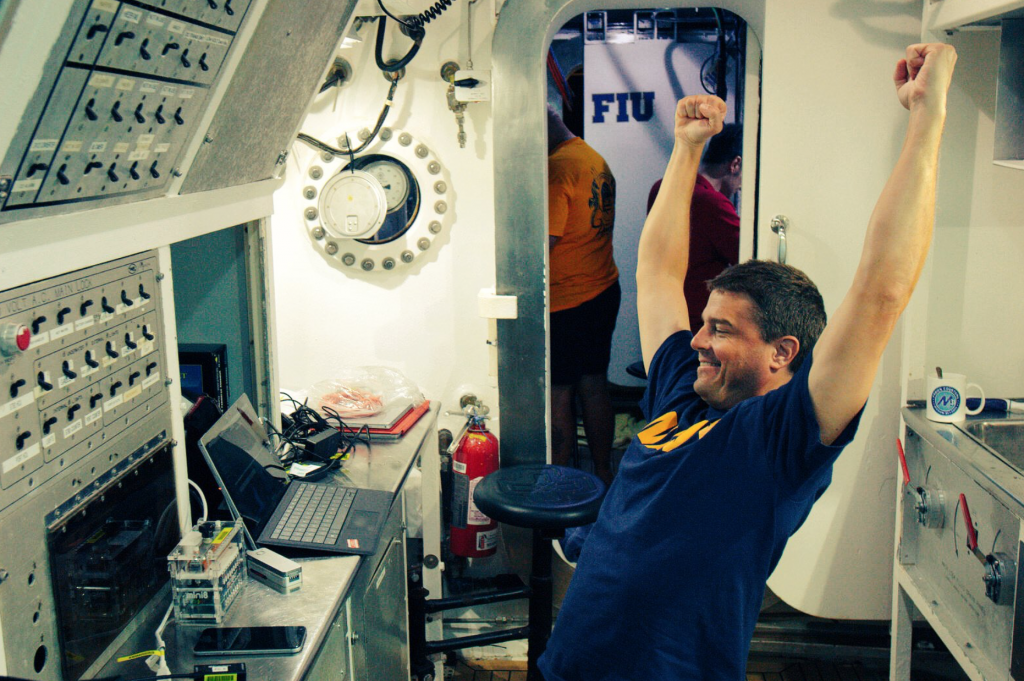
Reid is very happy to complete a successful DNA experiment!
Mission Day 4: Time at Depth
Published 7.24.16
We have samples! Today, the EVA team of Matthias and Reid collected our first coral sample for the FIU marine science team. The EVA was just over 4 hours, and they did everything from reef exploration to identify specific species of coral for potential monitoring, to sampling previously tagged coral colonies, to doing follow-up work on the coral nursery trees that were built in collaboration with the Coral Restoration Foundation…which brings us to the Team of the Day!
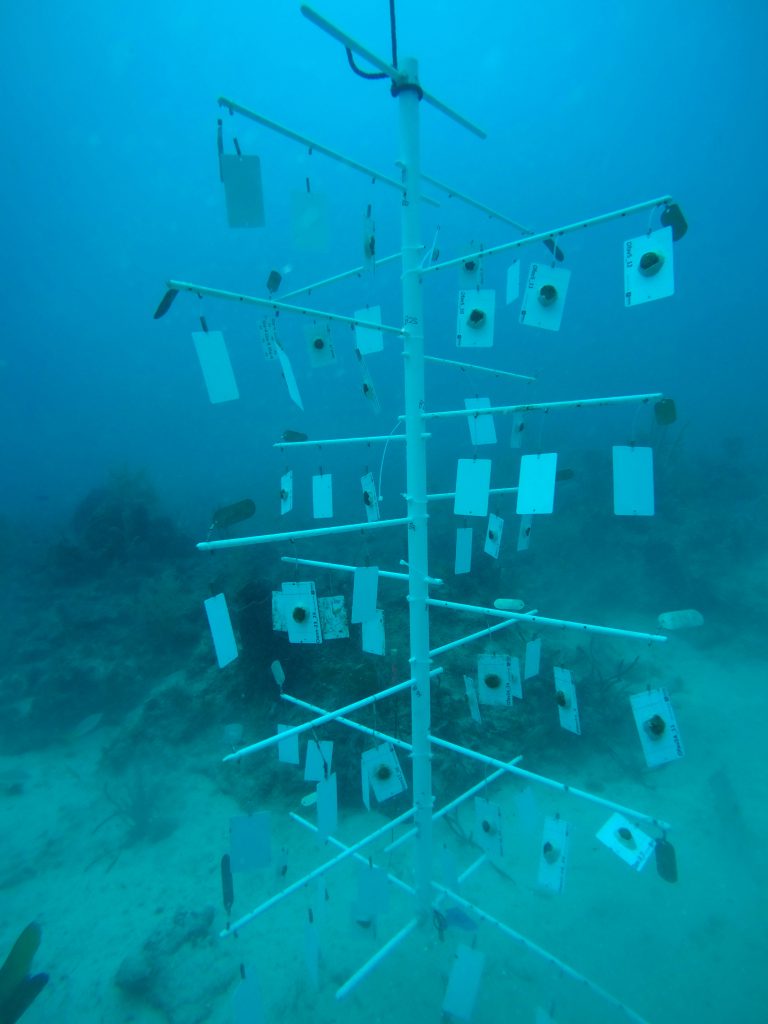
A constructed coral nursery tree, which will later be harvested for outplanting
Featured NEEMO 21 Team of the Day: Coral Restoration Foundation
The Coral Restoration Foundation (CRF), based out of Key Largo Florida, is a nonprofit ocean conservation organization working to restore coral reefs, educating others on the importance of our oceans, and conduct research to further coral monitoring techniques. This organization is dedicated to creating offshore coral nurseries and restoration programs for threatened coral species. These successful programs have allowed the CRF to take the lead in innovative nursery and restoration techniques that are implemented worldwide. At NEEMO 21, the CRF is teaming up with NASA and Florida International University (FIU) for the first time with a goal of setting up long-term coral nursery at the Aquarius Reef Base (ARB) site to support on-going research and restoration efforts. Initial research will include the comparison of growth, survival, and fitness of nursery corals grown at different depths. Future efforts will expand upon the foundation we establish during this year’s NEEMO mission to produce and grow additional generations of coral colonies for restoration and research. Ultimately, the coral colonies that are grown in the ARB nursery will be out-planted around Aquarius for long-term monitoring and throughout the Florida Keys to help restore the threatened reefs.
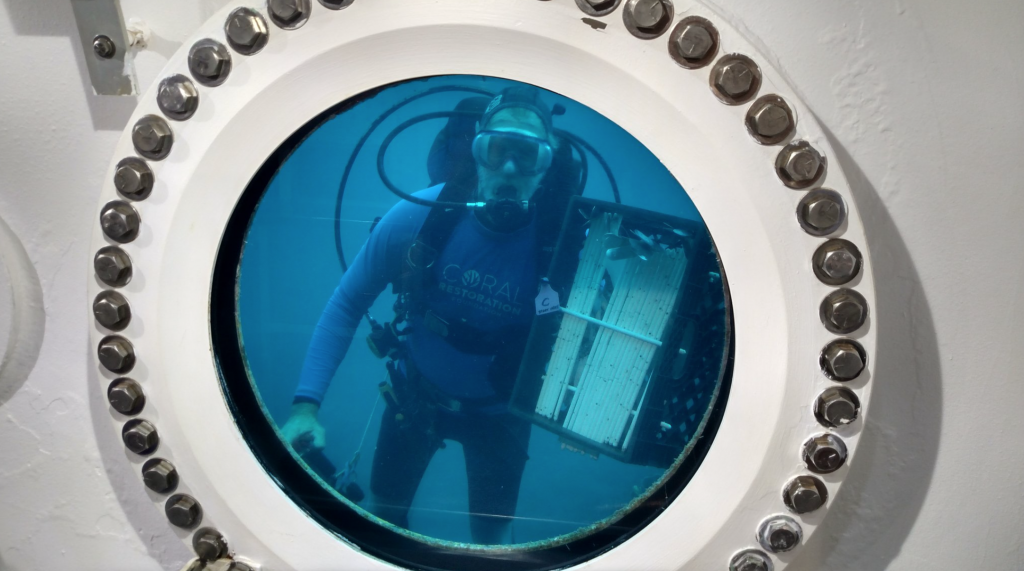
Coral Restoration Foundation Founder and President Ken Nedimyer delivering coral nursery supplies for the day’s EVA
The task for our aquanauts is to construct the “trees” for the nursery, secure them to the seafloor bottom, and populate them with different coral species which will start to grow. For us, it’s analogous to a “pioneering” EVA task. Pioneering tasks are those related to setting up camp on the planetary surface, as distinct from the exploration science EVAs.
Since Mission Day 2, the crew has been working hard on their EVAs to construct and collect data from the nursery trees. The entire crew was very excited about working with the CRF as both a task that is analogous to planetary EVA, as well as a way to give back to a reef that has supported Aquarius for 21 missions to date.
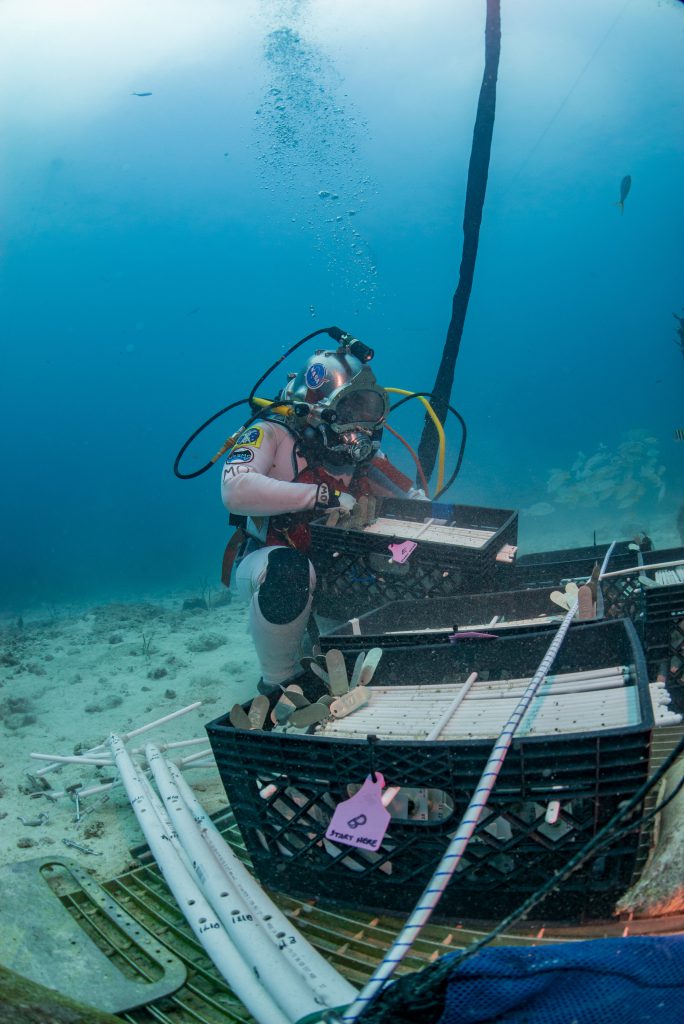
Marc O Griofa collecting tools for building a coral nursery tree
In addition to a very productive EVA, Marc and Megan were inside the habitat staying just as busy running through science objectives and manning the IV communication for the EVA.
Undersea update from Aquanaut Marc O Griofa:
“Another great day from beneath the waves. Amazing, challenging, engaging, mid-blowing and so many more words are what I would use to describe this experience!
Commander Ried Wiseman described this as being one of the best analogs that he has seen so far in preparation of astronauts for simulation quality and I would have to agree. The combination of effort from a crew that is working hard inside the Aquarius Habitat to the amazing team of scientists, engineers, CAPCOMs, mission specialists and operational planners is something to behold when you see it all come together! Needless to say not everything goes smoothly, but this is one of those areas where the operational “speed bumps” are taken into consideration and it is a fantastic to watch such a great team work in tandem to overcome them! This experience is my new definition of teamwork!
So, today was my first day as IV. I was the first “non-astronaut” trained crewmember who had the pleasure of sitting on console while my two crewmates Reid and Matthias were out on their 4 hour EVA (Extra-Vehicular Activity) exploration dive. So lets put a couple of things in perspective. This is a similar type of console setup that can be used in mission control when astronauts are doing spacewalks. There is data streaming in from every corner on multiple different screens. You are the “voice” link from the crew to “mission control” and in addition you are trying to keep abreast of multiple different data streams and timelines ranging from discomfort, operational efficacy and simulation quality. All of this data helps the science and exploration teams to devise better techniques and tools for spacewalks and missions on another planetary body like Mars.
Heres where the perspective comes in … You have a mission control room full of VERY highly trained scientists from multiple space agencies who do this for real with a space station 100 miles above the earth, an astronaut and an astronaut technology specialist in the water whom are both extremely experienced, multiple scientists who are counting on the data from the dive for coral research and restoration, new tools being tested for doing future spacewalks on Mars … and then you go and stick an Irish doctor directly into the data choke point for this entire operation and hope he can juggle all of the balls for 4 hours! This also became my new definition of drinking from a firehose!
Reid and Matthias did a fantastic job of sampling the coral and meeting the objectives for the Coral Restoration Foundation and FIU at both the Mercury Coral Nursery and the exploration part of the mission. This experience also gave me a unique and valuable perspective on the type of inputs needed when astronauts do spacewalks and just how valuable an analog that NEEMO is in the preparation of new techniques, technologies and procedures for a future mission. Onwards with our #JourneyToMars!”
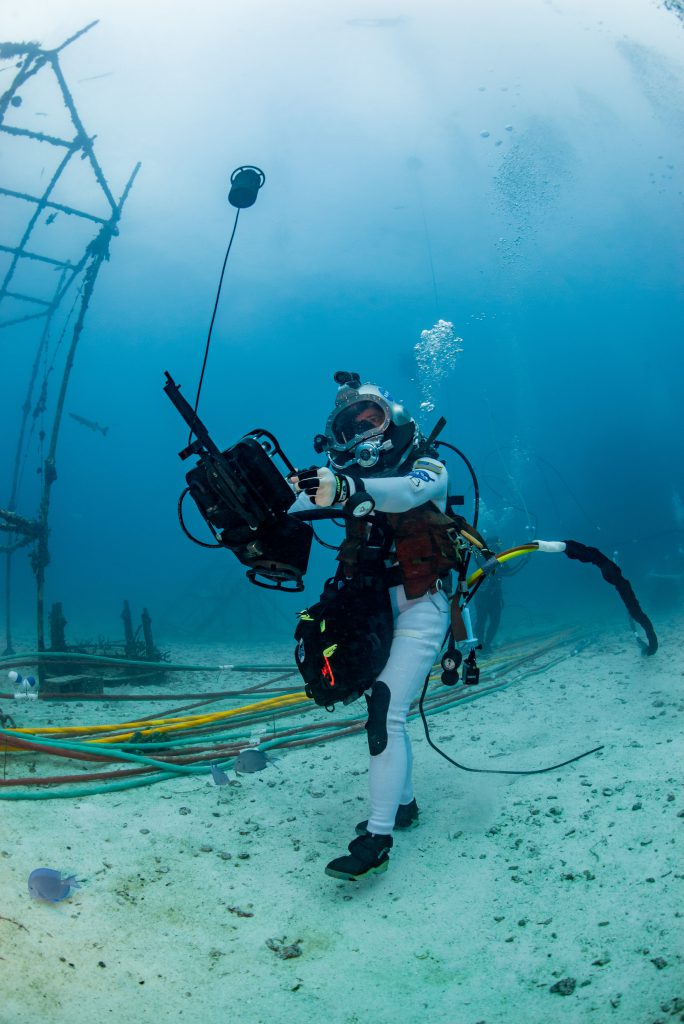
Megan Behnken on EVA navigating to a designated work site
As mentioned in the Mission Day 3 update, and like crew members in space, the crews’ daily schedules are scripted by Mission Control to ensure that all of the mission objectives are met.
Crew Commander Reid Wiseman compared NEEMO timeline management to his experience on the ISS:
“Time pressure – at the end of Mission Day 4, we are still stressing a bit from the perceived schedule pressure. Our entire day is planned by the mission control team. They do their best effort to estimate how long each task will take us. Much like on the space station, the learning curve for the crew is steep when you’re new…and right now, we are all new which means we are slow! I can tell after a week or two of experience down here, we would be able to handle routine science with ease. But right now, DNA sampling is tough, exercise setup is tough, even getting through meal time is tough. Because of that, our efficiencies are lower than they could be. As the day rolls along, a thin vertical red line on the schedule shows us the actual time. That red line becomes the pace car down here as it does on the space station. Completing a task before the red line catches you feels great, but watching the red line track past your current task means you are behind and chasing that line becomes a burden. To date, we’ve done alotta chasin’….”
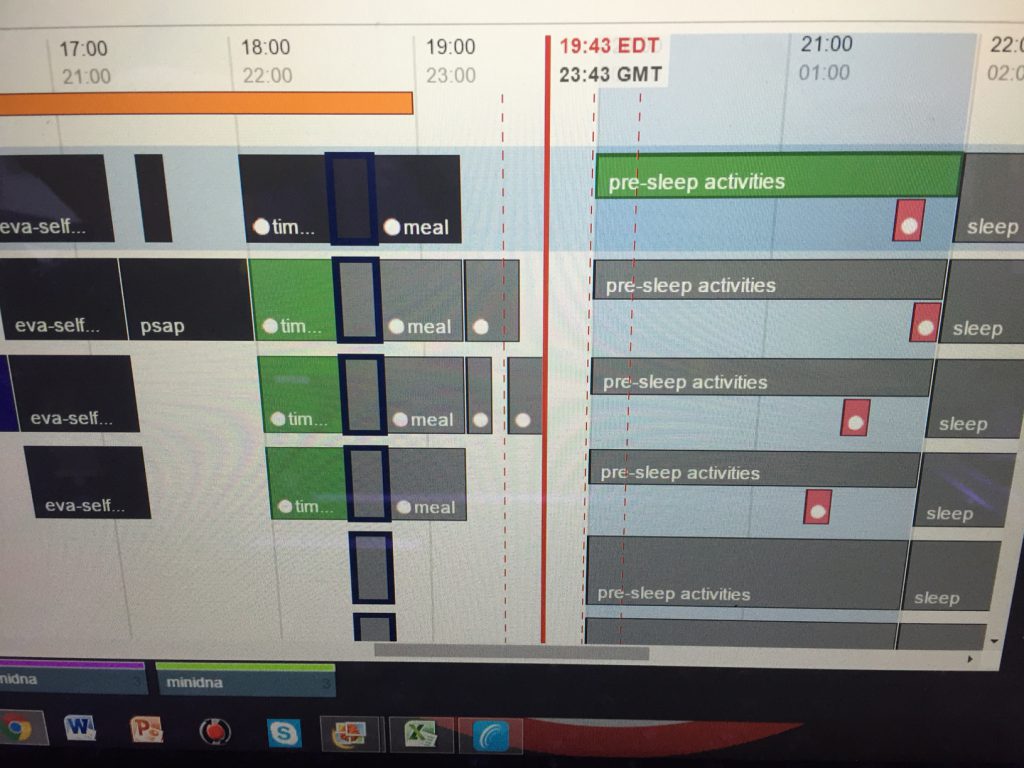
The red line in Playbook allows crew members to compare actual time against a given task’s scheduled time
While the extreme environment and remote operations lend to a space-like environment, the incorporation of time pressure, delayed communication, EVA operations, and team coordination (among many other things) are the features that make NEEMO such a convincing analog for space exploration!
Mission Day 3: It Takes a Village
Published 7.23.16
For each of the 6 crew members, there are around a dozen or so research and support team members – at a minimum – that make a mission like NEEMO move forward successfully and productively. With so many operational objectives embedded into the 16 days underwater, there are multiple moving parts, pieces, and personnel who ensure it is done smoothly and as efficiently as possible.
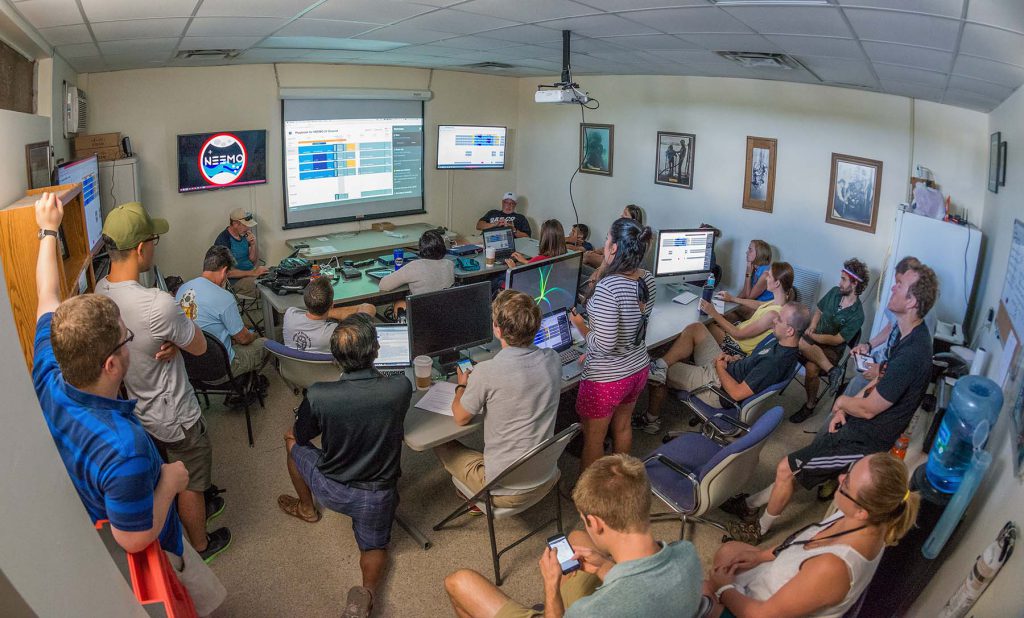
Playbook review meeting in NEEMO Mission Control
Tying together all of the planning and execution of the mission objectives with the crew’s living and working schedule is no easy feat! Thankfully, we have the Playbook team to manage the mission plan and schedule…
Featured NEEMO 21 Team of the Day: Playbook
(NASA Ames Research Center)
For this mission, our plan execution tool is Playbook, which is developed by NASA Ames Research Center and specifically designed for use by crew to support mission operations. It is mobile, web-based, and designed to be flexible enough to work on a tablet device or in a traditional web browser. Used as the primary mission operations tool, Playbook allows controllers and crew to see the mission plan and schedule changes in real-time or through fully simulated time-delay. New features under evaluation include one that makes it very easy for the crew to collaboratively self-schedule flexible tasks, create new tasks, add groups of tasks to the timeline and keep the ground informed as they do so.
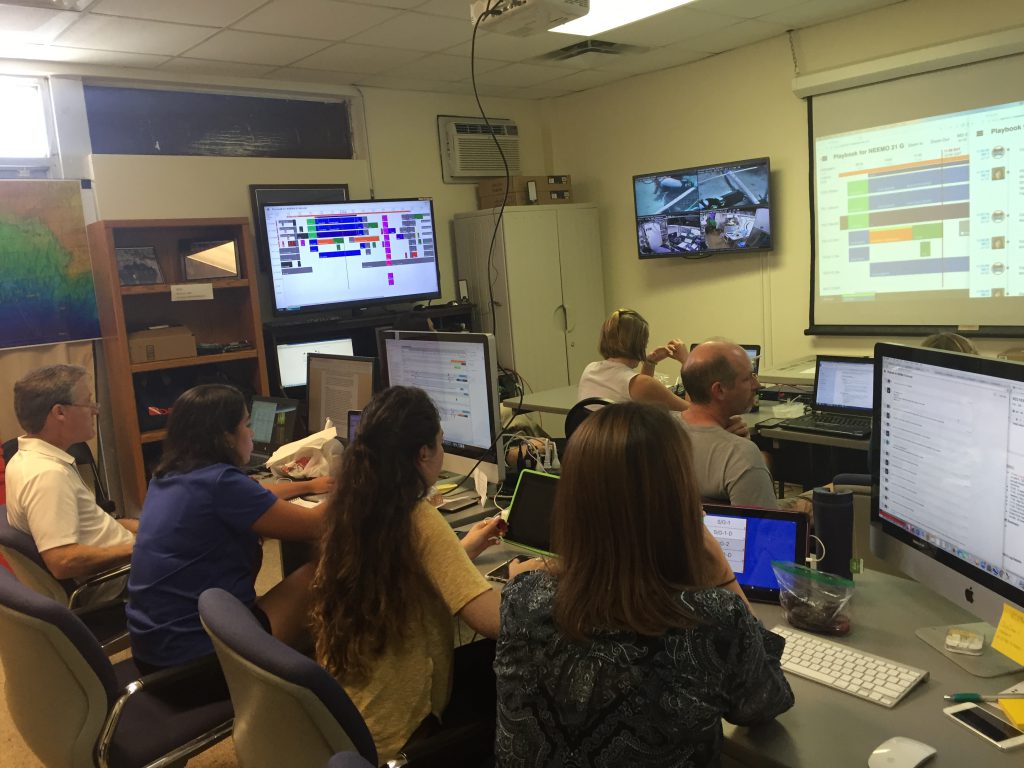
Mission Control at Aquarius Reef Base monitoring crew members on EVA
Playbook has a number of objectives related to crew self-scheduling we will be looking at, and crew feedback will continue to make this tool even more capable. In addition, the team has added in more functionality to the Mission Log, a text, photo, and video communication tool for crew and mission control to communicate with one another. This feature has been enhanced this year with the ability to send priority messages, which are messages that are highly visible and must be explicitly acknowledged, ensuring mission control or the crew that the high priority messages they sent were seen, received, and understood. There is also a new feature giving the ability to search all messages in real time, to allow mission control and the crew to easily refer back to past messages or to see all messages in a related thread.
Playbook previously flew on ISS as an objective of the IRISS mission of Andreas Mogensen in Sept., 2015. It will also be flying again during Increment 50 as a task list objective for Peggy Whitson! The team of Ivy Deliz, Jessica Marquez, Steve Hillenius, Bob Kanefsky and Jimin Zheng is working hard to keep us all on track, efficient, and sane for each and every objective-packed day – thank you, Playbook team!
For the saturation crew, Marc and Megan conducted their first EVA, which included building the world’s deepest coral tree nursery at ~90 FSW! They rocked their EVA objectives and then made their way back to the habitat for a link up with the History of Diving Museum, homemade cookies (courtesy of Megan’s thoughtful planning), and completion of additional in-habitat objectives. Along with Matthias, Reid was in the habitat today to run the intravehicular (IV) communication with the EVA team and conduct additional studies, such as testing the MED 2.0 exercise device.
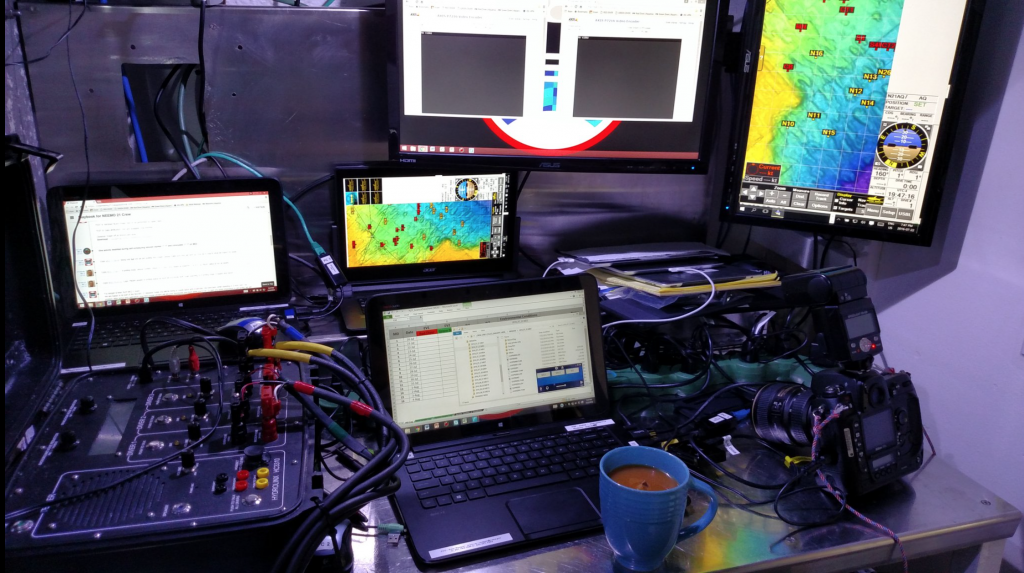
IV Communication station inside of the habitat, complete with a hot cup of tea!
Matthias also had an exciting day as he became the first to collect a sample and sequence DNA from that sample using the miniPCR system, which all of the crew members will have a chance to test over the next two weeks! More details to follow on these individual objectives in future blog updates, so stay tuned!
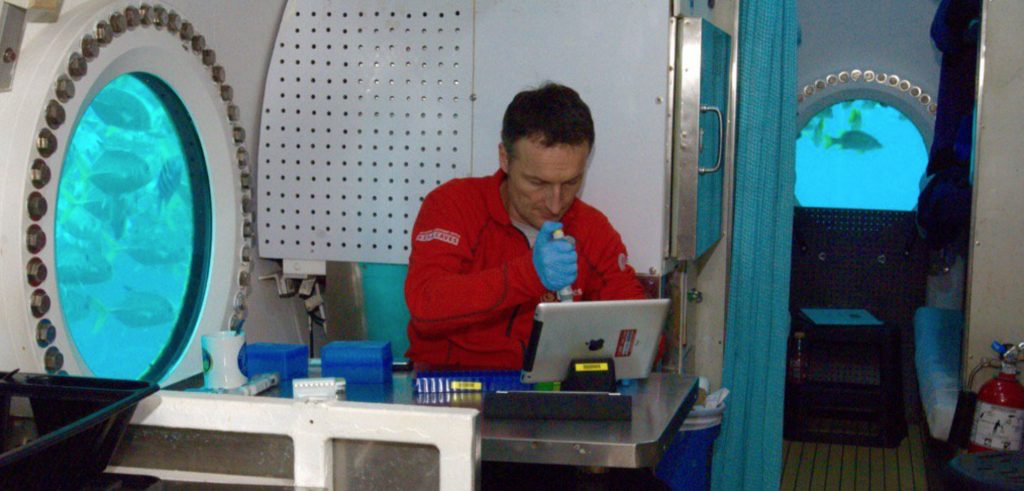
Matthias sequencing DNA from a swabbed sample he collected inside the habitat
As I was writing this update, I received word from Marc and Reid that they conducted their first night dive out of the habitat. Both of them said it was the best dive ever 🙂
Mission Day 2: Life Aquatic
Published 7.23.16
It’s official! As of 10:28 AM ET on Mission Day 2, Reid Wiseman, Megan Behnken, Marc O’Griofa, and Matthias Maurer are officially Aquanauts after having lived underwater for 24 hours. On that note, both Megan and Reid are now the 49th and 50th Aquastronauts (meaning they are aquanauts who have also been in space). Congrats to the crew!
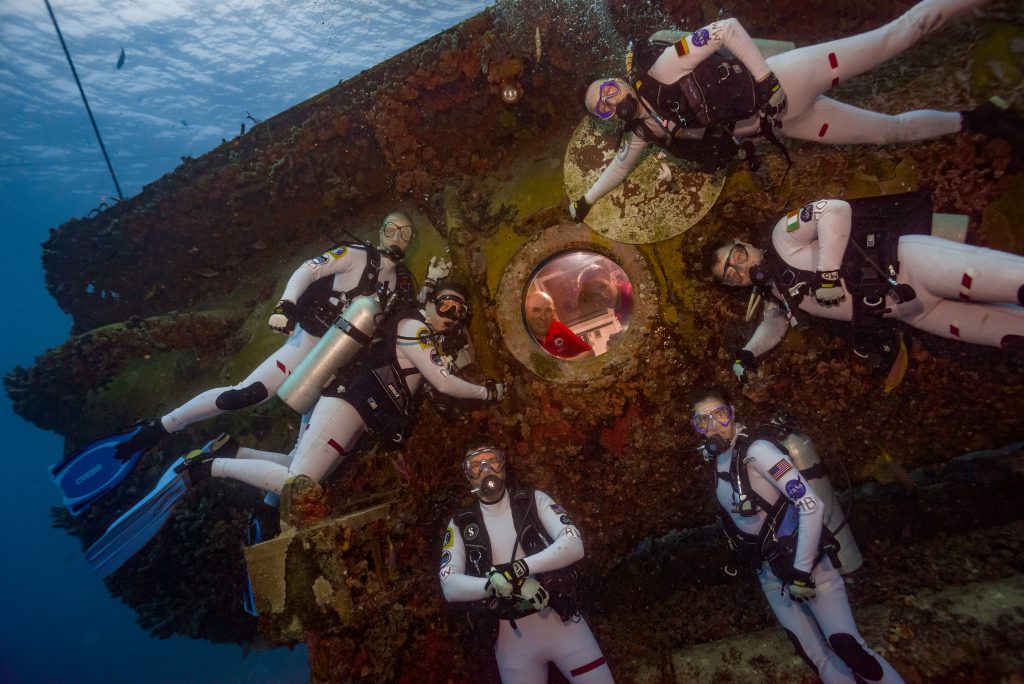
Mission Day 2 was jam-packed with science and operational objectives, as every day is planned to be for this mission! The crew started their in-habitat and EVA objectives, including the DNA sequencing, sensorimotor testing, nutritional assessment, optical communication testing, and coral nursery tree construction on the Mercury (shallow) site.
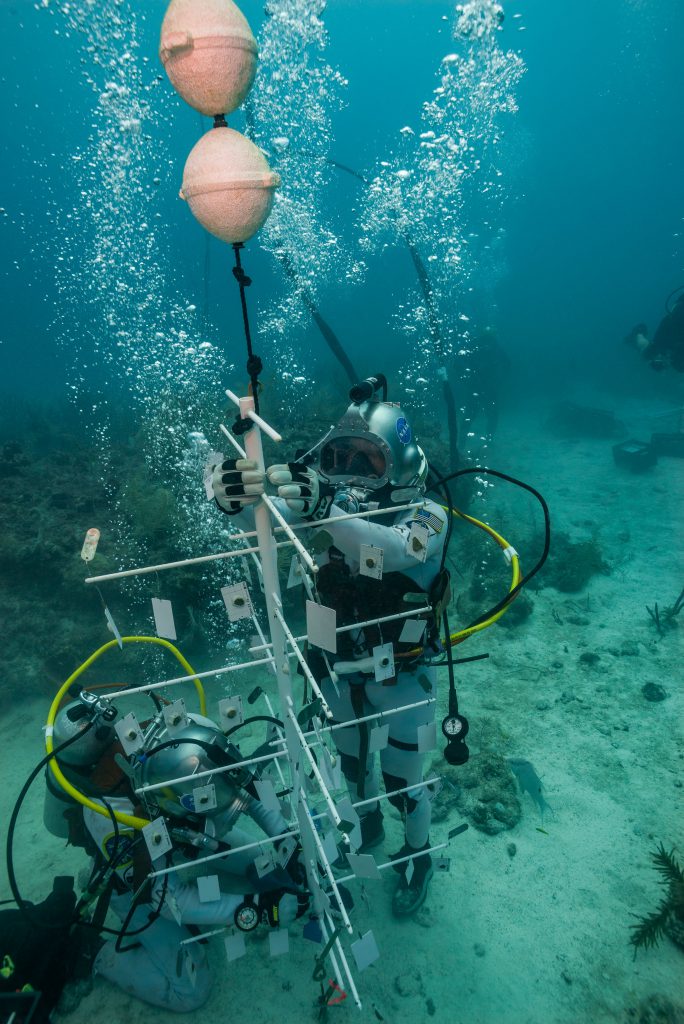
A Coral Restoration Foundation tree under construction by Maurer and Wiseman
Throughout the mission, we will provide details on each of the science and operational objectives in each blog post as a ‘Featured NEEMO 21 Team of the Day’ – first up is optical communication testing!
Featured NEEMO 21 Team of the Day: Free-Space Optical Communication
(Embry-Riddle Aeronautical University/Micro Aerospace Solutions)
For pioneering missions to Mars, establishing reliable and robust communication and data links will be one of the first and most important tasks for the crew to accomplish. Not only is communication between crew-members vital for team coordination and performance, it is necessary for all surface operations, from deployment of habitats to science-based exploration on planet surfaces. However, traditional radio frequency communication systems require large amounts of power and are bandwidth-limited (low data transfer). A solution to improve these communication issues is to utilize Free-Space Optical Communication (FSOC) systems that have the potential to allow for more reliable and faster data and voice communication links between the habitat and crews conducting extravehicular activities (EVAs). FSOC also requires less power for transmission, thus potentially offering battery and weight reductions on EVA suits. Although FSOC is limited in distance to a few hundred meters and requires a direct line-of-sight between transmitter and receiver, these systems can transfer significantly more data than traditional radio.
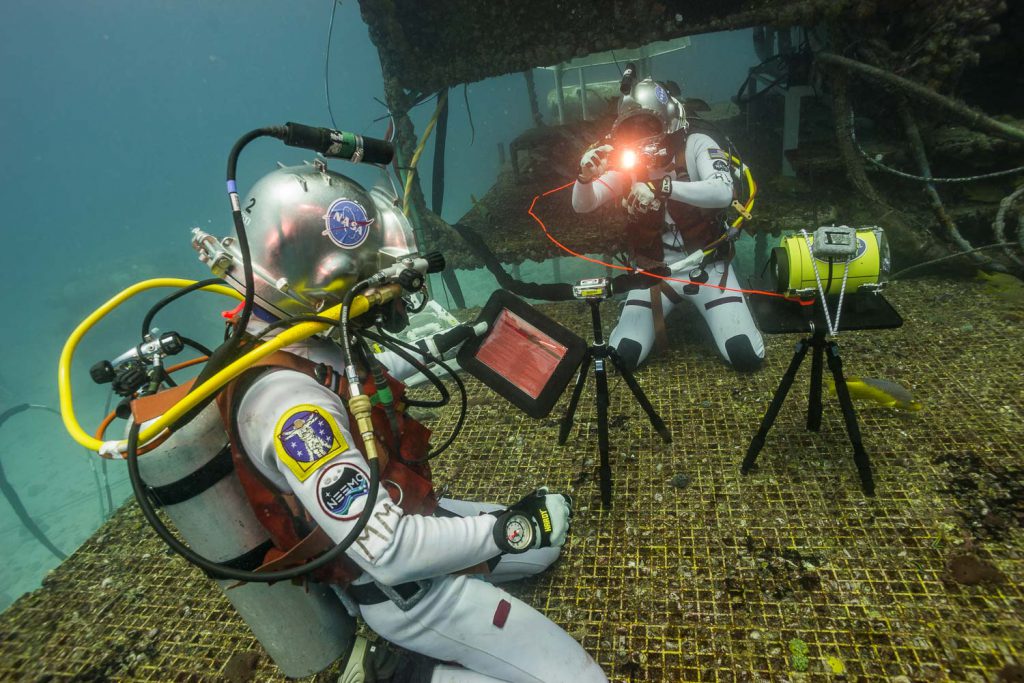
Aquanauts Matthias Maurer and Reid Wiseman conducting optical communications assessment
The team Embry-Riddle Aeronautical University and Micro Aerospace Solutions has designed an FSOC system for evaluation for deployment and evaluation during NEEMO 21. Results will not only support recommendations for utilizing FSOC for surface operations on Mars, but could potentially lead to new applications for underwater operations here on Earth for the US Military and oceanographic researchers.
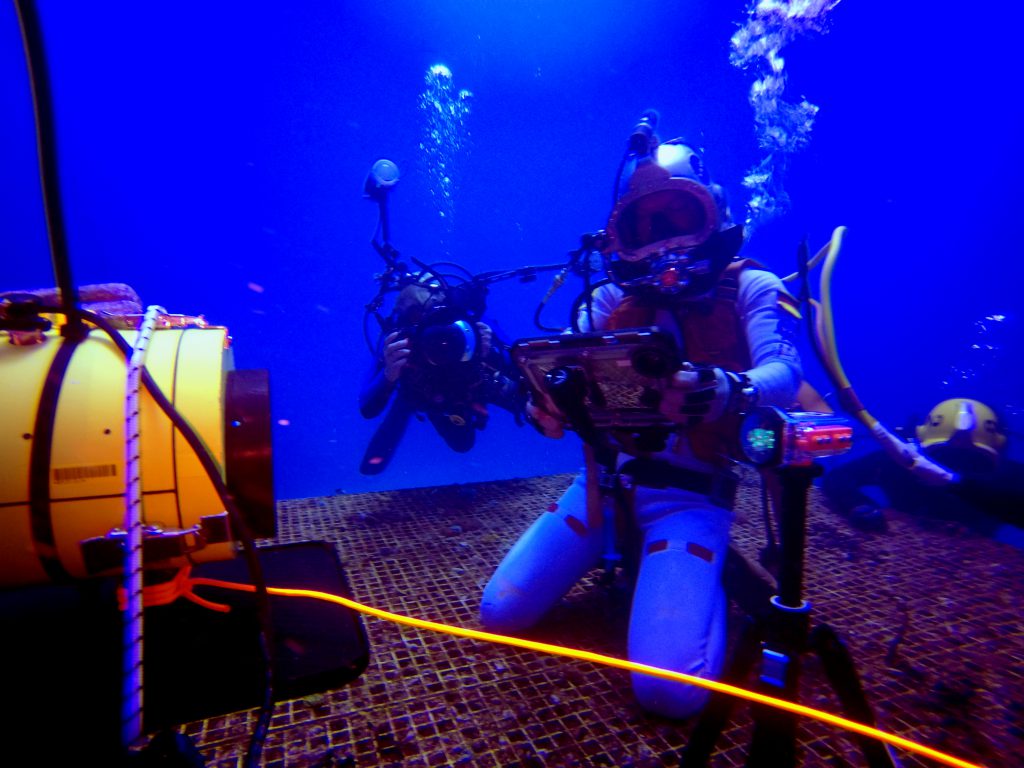
Maurer testing optical comms while being photographed by Karl Shreeves
In addition to working through the objectives, the crew had a surprise visit by the Chief of the Astronaut Office, Chris Cassidy. Chris had a chance to tour Aquarius Reef Base, followed by two dives at the Aquarius habitat to see the in-water operations and say hi to Megan, Reid, Matthias, and Marc. Everyone was excited to have him on site!
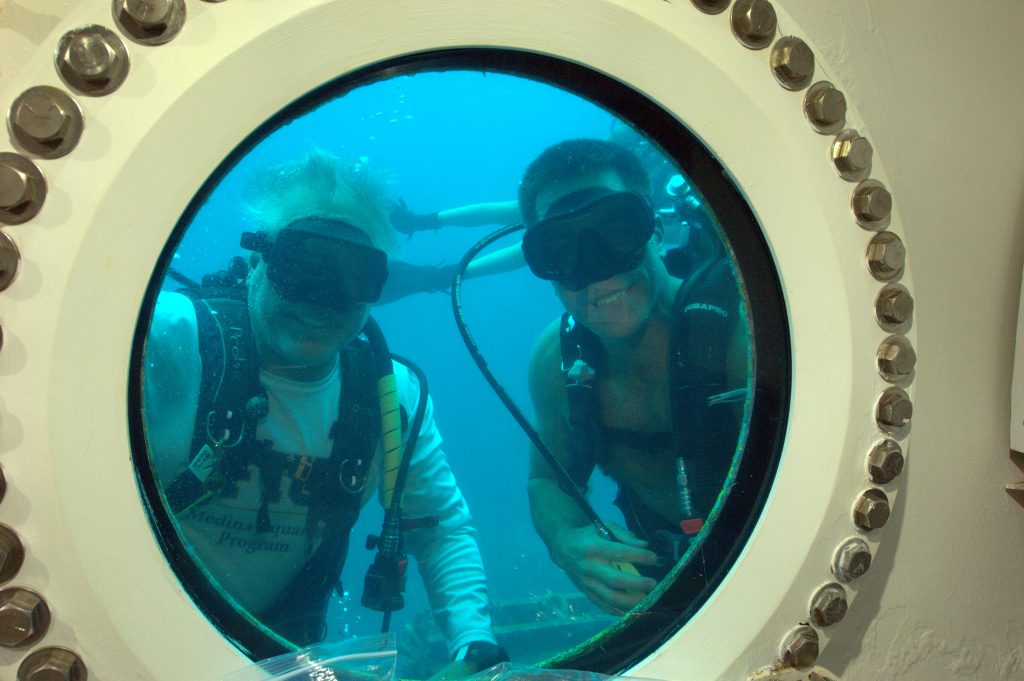
NEEMO Founder and Program Manager Bill Todd and Chief of the Astronaut Office Chris Cassidy visit Aquarius
The other surprise for the day was Noel and I diving into the habitat for a crew photo, to say hi to our team, and….drumroll…a link up with the International Space Station! Ocean to space, we swapped stories and other-worldly views with astronauts Kate Rubins, Jeff Williams, and Takuya Onishi (all NEEMO aquanauts from previous missions). They took us on a ‘swim’ through the ISS, turning the cameras around in the cupola so we could see the Pacific Ocean from space. I have to admit, I had goosebumps and was a little choked up to see Mother Earth from their view, with fish swimming around behind the laptop screen. We were all grinning ear to ear as we sent our farewells and best-of-luck wishes to the ISS crew from underwater!
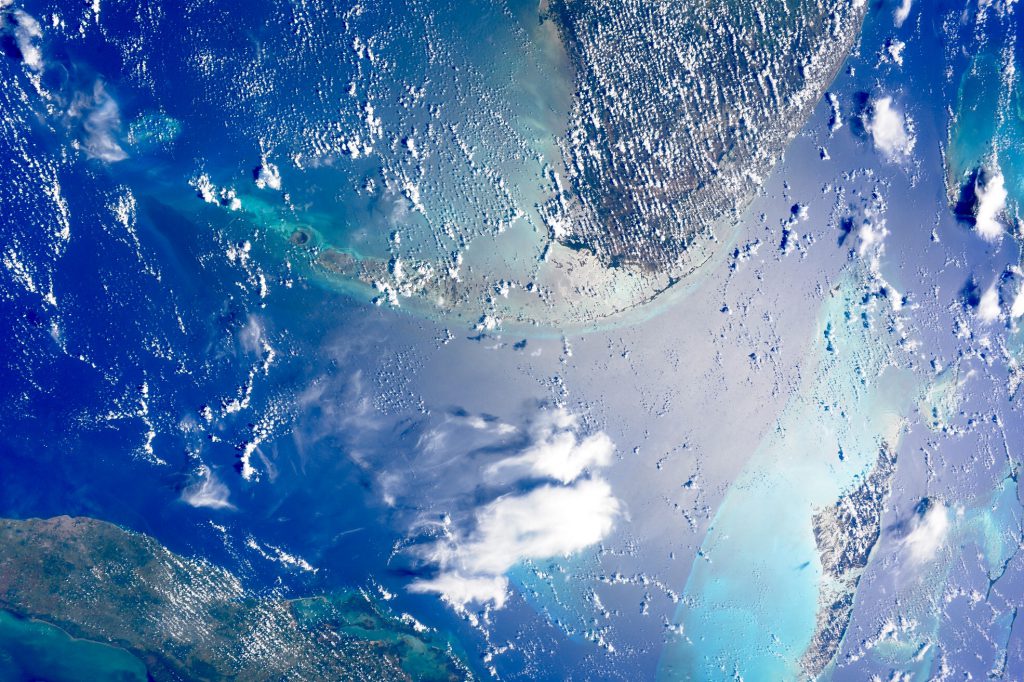
Astronaut Takuya Onishi sent the NEEMO 21 team this spectacular ISS view of the Florida Keys
From the crew below, we received an update on the first full-day in saturation.
From Dr. Marc O Griofa:
“Day 2 started out very busy … at approximately 4am …
I had set my alarm for 5:50am as I was going to be the first up the following morning to set up for the VEGA Telehealth monitoring. I had set up the equipment the night before but murphy’s law says I should trust but verify!
In the middle of the night my alarm clock actually falls off my bunk to the floor behind the air filters, and I have visions of it going off at 6am and the entire crew cursing me out! This was not the way I wanted to spend my first morning in Aquarius so I stumbled around in the dark for 15 mins cursing myself until I found it! Success!
We started off the morning by each of the crew being monitored on a wireless enabled state-of-the-art telemedicine solution. All of the equipment is linked to the wifi network of the habitat and the data transmitted to a cloud server where it can be viewed by a topside medical officer in mission control. This provides a far greater level of awareness of the crew and their needs from a medical and performance aspect. The lessons learned from the crew help improve the next iteration of the system with a potential application for long duration spaceflight but will also have significant impact on improving the system for conventional medicine application as well.
Thank god the entire system worked the first time and we had to do almost no troubleshooting. I was able to breathe a sigh of relief as I had to pull each weary crewmember out of bed to do their first round of telemetry. One of the key pieces of equipment that we are using on this mission is the ZOE Fluid Monitor. This monitor works on the basis of basis impedance and provides an objective fluid or hydration level for each crewmember. This is really key as we progress forwards throughout this operationally intensive mission as it is very easy to dehydrate, especially with 4 hour long dives as extra-vehicular activities (spacewalks) on the seafloor where you cannot drink at all. This is just another of the measurements that we can introduce to help monitor and improve the overall health and performance of the crew.
Im running a little thirsty tonight so Ill be sure to drink up before my EVA tomorrow.
More updates on adventures in DNA sequencing and MiniPCR to come tomorrow …
Aquarius out!!! – Marc”‘
The mission is running swimmingly, so to speak! Stay tuned for Day 3 updates…
Mission Day 1: Splash Down!
Published 7.21.16
…and we’re off!
NEEMO 21 splashed down today at 10:28 AM ET. Even with grumbling skies and a few downpours, the crew was ecstatic to hop on the boat and head out to the Aquarius habitat after a 3-day weather delay.
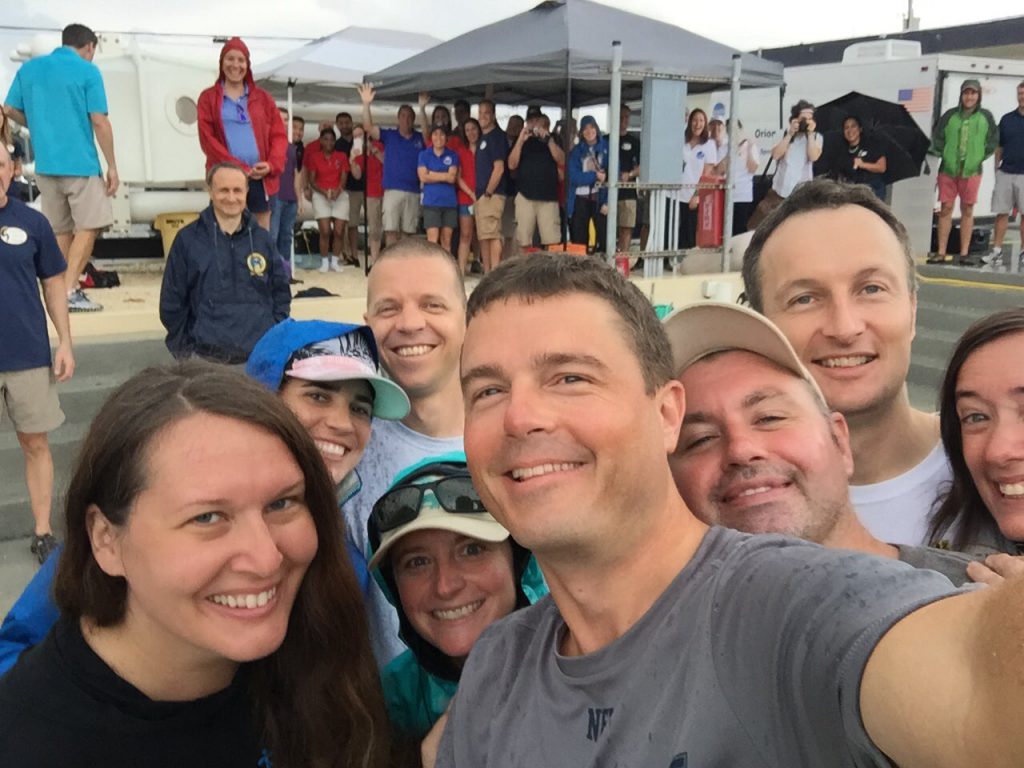
NEEMO 21 crew, research, and support teams ready to kick off the mission!
After a few rounds of photo opportunities in our shiny white wetsuits (well, some are shinier than others), we all hopped in for a round of in-water crew photos before the saturation mission began. The thunder rolled and the skies looked ominous in the background, but the calm sea state and the excited mood of the crew overcame the dreary weather.
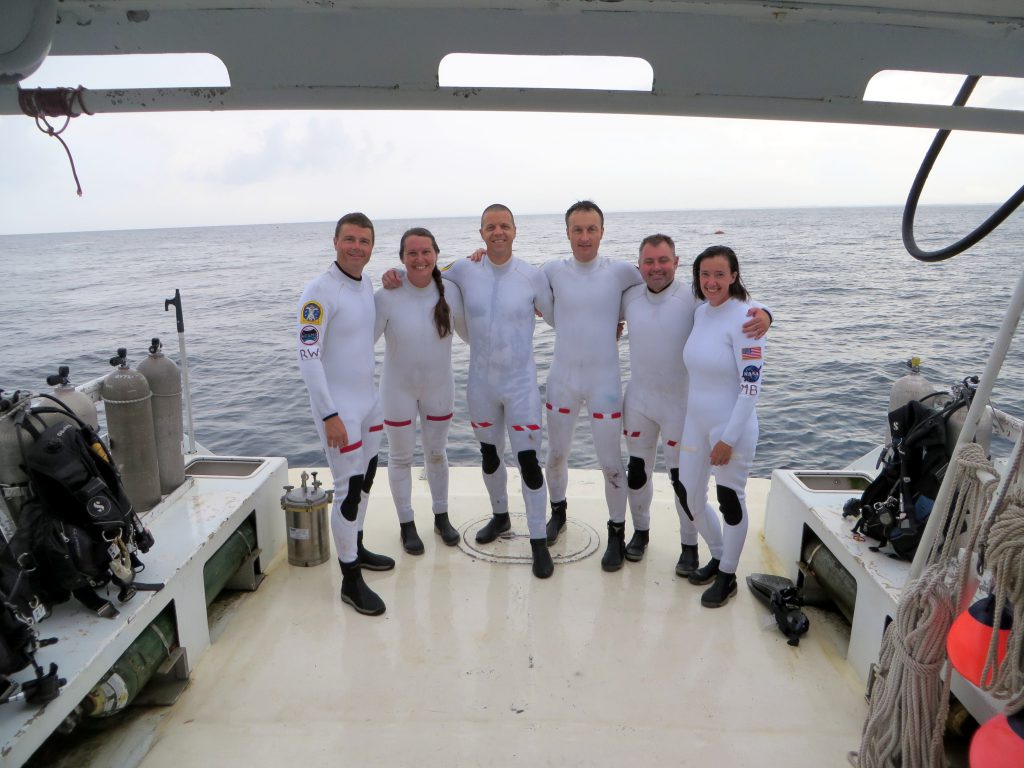
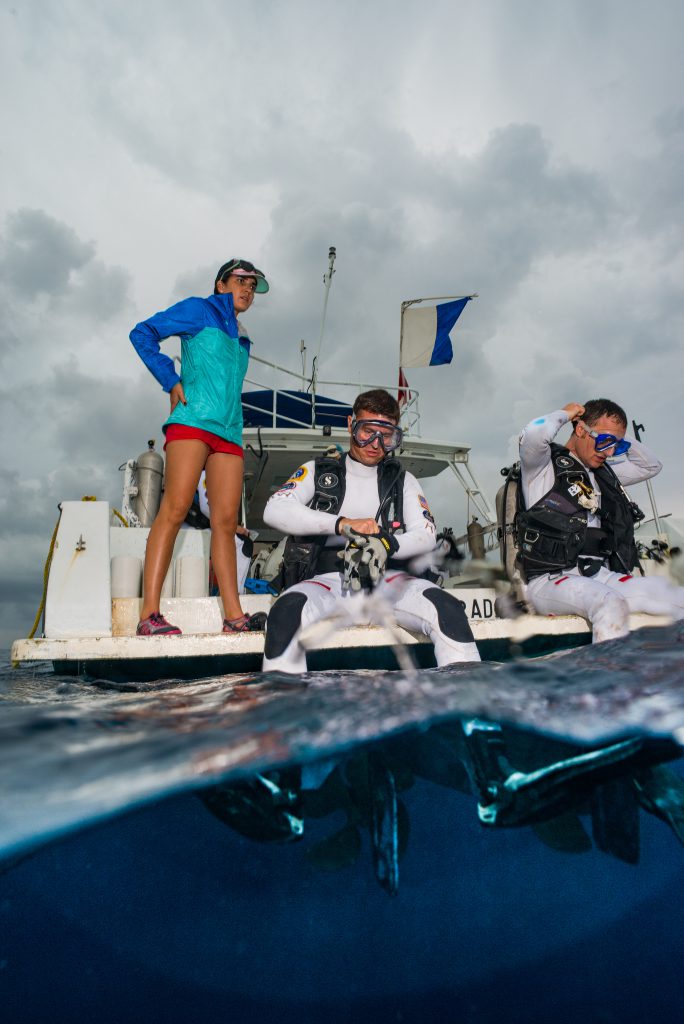
Ivana assists crew members Reid Wiseman and Matthias Maurer as they enter the water prior to splash down
Our fabulous photographer, Karl Shreeves, got some great shots of all 6 crew members (combining the two 8 day missions). It was a lot of fun to have everyone together one last time before the first crew climbed into the habitat! After wrapping up our photos, it was a round of handshakes and big hugs as Noel and I wished our crewmates the best of luck. As we swam away from the habitat, we could see the crew members settling into their new living quarters through the habitat windows – so excited for them, but also anxious to return in 8 days to switch with Reid and Marc for our own 8 days in saturation!
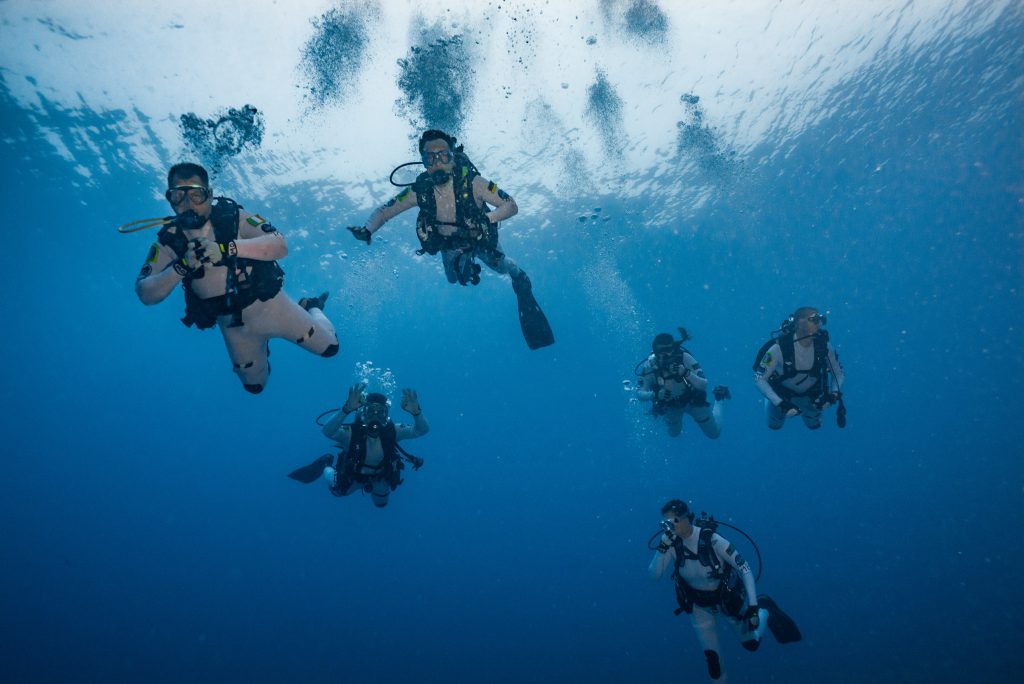
The crew descends to the habitat for splash down
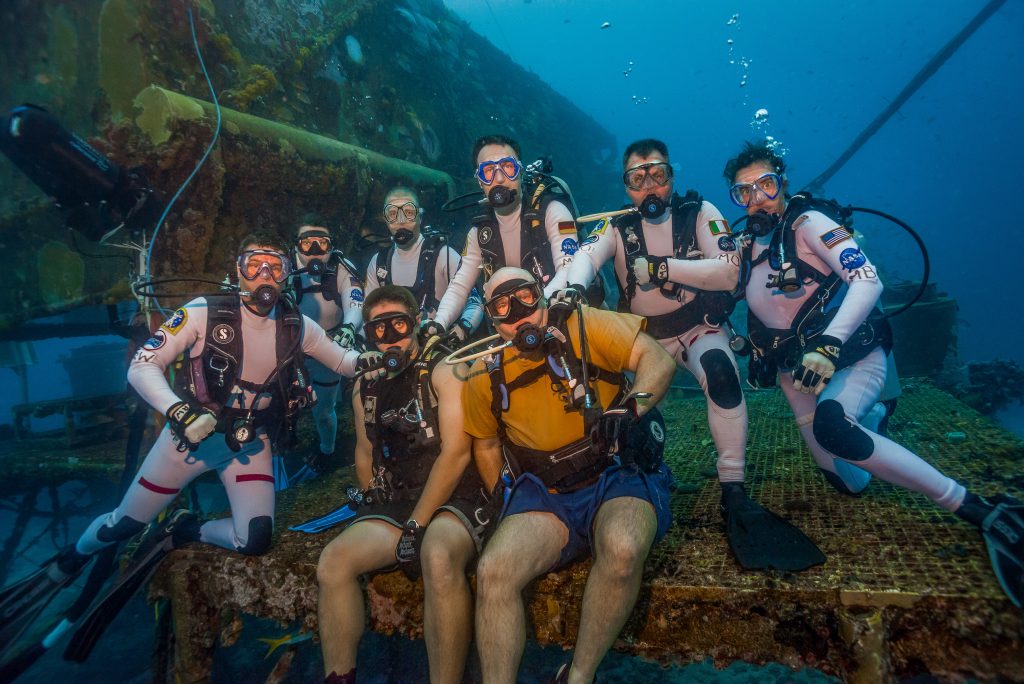
N21 Crew (l to r: Wiseman, Kernagis, DuToit, Maurer, O Griofa, Behnken) with Hab Techs Moore and Stark
As Noel and I returned to Mission Control Center at Aquarius Reef Base, the first saturation crew settled into their new home.
Day 1 report rom Commander Reid Wiseman:
“Since we said goodbye outside the hab (which was more emotional than I expected!), we have been incredibly busy. I am always amazed how frustrating yet exhilarating it is to experience a completely new environment. This feels very similar to Day 1 on the space station. There are so many incredible views outside I can’t decide between working and taking it all in.
After coming into the hab, we had a quick safety briefing from Sean and Hank. Emergency procedures are simple but critical. Fire and contaminated air are the biggies. Loss of power is not as critical, but it starts the clock on our resources. It took about 20 minutes to go through the specifics.
After that, Marc and I rehydrated some Mountain House food. Chicken and rice as well as good old chili mac. The four of us split those two as a trial. Delicious! No doubt I can live off that for as long as needed.
Soon after lunch, the Hololenses came down from topside. Megan and I donned them and began the tedious chore of unpacking. Initially we were frustrated with the gear but we soon learned the nuances and it became an effieicnt system. One humorous thing – in the tiny habitat, any time Megan would make a Hololense gesture to close a window or complete an activity, it would execute her gesture in my Hololens as well. I learned to adapt to this but it made for some funny first moments!
Sean and Hank prepped the helmets for our first dives. We did quick 40 minute excursions in 2-man teams to learn how to exit and enter the hab as well as umbilical management. The time outside was spectacular. We all were able identify the four primary corals we are looking for this mission. Very easy to spot the Agaricia humilis. Following the first excursion with Matthias, we watched as Megan and Marc went out, which allowed us to learn the radios and laptops that we will use to guide them on their ‘space walks’ in the coming days. Overall, the operations went far smoother than expected.
Another round of Mountain House for dinner. We were all extremely hungry and you could hear a pin drop during dinner… No witty banter, just food consumption. After dinner, most of us called home to say hi to our families. Hank turned the outside lights on after sunset and the world outside came alive. We had huge fish, tiny fish, and unidentifiable fish all coming to say hello. It was impossible to pull oneself away from the view ports to head to bed. I’m sure this will all become the norm soon, but for now it is sensory overload and it is awesome!”
Day 2 kicks off research for NEEMO 21, and a fun surprise for the entire crew! Updates to follow as we plan to blog each mission day moving forward.
Countdown to Splash Down
Published 7.17.16
Training week is a wrap!
The crew spent Training Days 5 and 6 immersed (literally and figuratively) in learning more about the science objectives and related procedures for the mission. On Thursday, we headed out to a dive site known as ‘Hens and Chickens’ with several of the FIU marine science researchers. For the first dive, we learned how to identify the 4 coral species will be sampling for the marine science team during our extravehicular activity (EVA) excursions: Orbicella faveolata, Orbicella annularis, Agaricia agaricites, and Agaricia humilis. Our instructors taught us the distinct features of each coral, then they quizzed each of us throughout the remainder of the dive. They even threw in a few trick identifications to keep us on our toes! We also learned how to place temporary tags and photograph the coral – information that will go back to the science team so they can decide which coral we should sample.
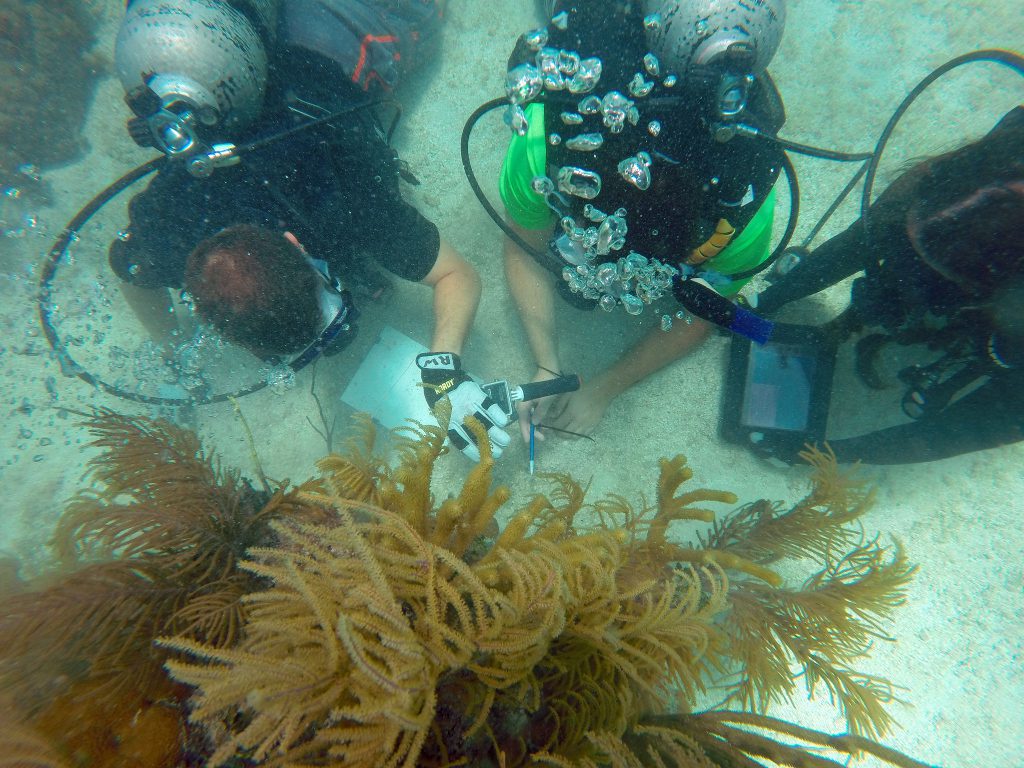
Reid Wiseman and Dawn Kernagis learning to identify coral with FIU’s Dan Merselis
For the second and third dives, we got our hands on the different tools we will be using during our EVA excursions. We practiced building a coral tree underwater, using the Pulse Amplitude Modulated (PAM) fluorometer to assess photosynthetic efficiency of each coral species, sampling and preserving coral specimens, and using the tool sled for carrying our research equipments throughout our EVAs. We also got hands-on time with the Shark Marine underwater navigator that we will use to travel efficiently throughout our simulated spacewalks – it is an impressive piece of equipment that will be much-needed throughout the mission. The dry training that we had on all of this equipment prior to hopping in the water to try it out made our training day very productive!
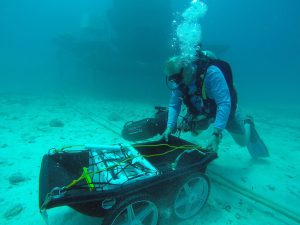
Setting up the tool sled that will be used during EVA excursions to carry the necessary research equipment
Friday was the final training day! We went through a brief review of additional science objectives, software, and hardware followed by an EVA ‘walk-through’. For this simulation, we had our intravehicular activity (IV) console set up in our training room, and the crew members talked through the communication, data capture, and operational procedures for one of the planned EVAs. Piecing together all of the training, equipment, and hands-on experience we had collected up to that point was incredibly useful and went well – plus it left us ready to get into the water and start the mission! It also spoke volumes with respect to the high quality training, preparation, and planning from the NEEMO staff and support team, which the entire crew has noted and undoubtedly appreciates.
On Monday morning, July 18th, the first crew (Reid Wiseman (NASA), Megan Behnken (NASA), Matthias Maurer (ESA), and Marc O Griofa (Teloregen/VEGA/AirDocs), and FIU Habitat Technicians Hank Stark and Sean Moore) will splash down to start their 8 day mission in the Aquarius habitat. Noel Dutoit (Naval Postgraduate School) and I (Dawn Kernagis, IHMC) will be working on our research objectives and supporting the team in any way we can for the first week before splashing down on July 26th, replacing Wiseman and O Griofa as they splash up. We are all chomping at the bit to formally kick off NEEMO 21!
For NEEMO 21 Mission updates, follow https://twitter.com/dawn_kernagis
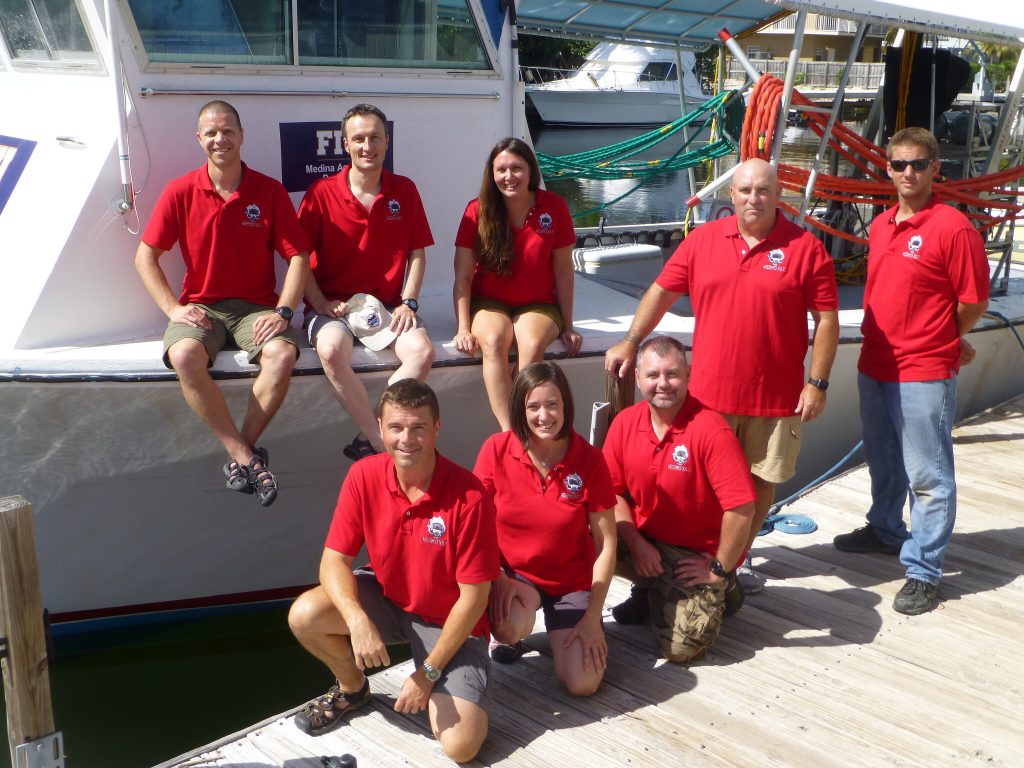
NEEMO 21 Saturation Crew: Bottom row: Wiseman, Behnken, O Griofa, Stark, Moore; Top row: Dutoit, Maurer, Kernagis
Topside, this is Green Diver
Published 7.13.16
As mentioned in the previous post, a major part of our crew training week has been learning how to dive the Kirby Morgan Stainless Steel 37, which is a helmet used for surface supplied diving. With this helmet, we have a continuous air supply in addition to communication capabilities through a connected diving umbilical hose that runs back to the dive boat (when we are living in Aquarius, the umbilicals will run back to the habitat). These umbilicals are different colors (green, red, and yellow), and we use these colors to denote which diver we are speaking to on comms. For example, when ‘Green Diver’ is talking to the topside crew, we say ‘Topside, this is Green Diver…’ and proceed with what we want to relay back to the surface.
The reason we are training on the hard hat diving system – we will be using this equipment when we perform our simulated ‘spacewalks’, otherwise known as extravehicular activity (EVA), during the mission.
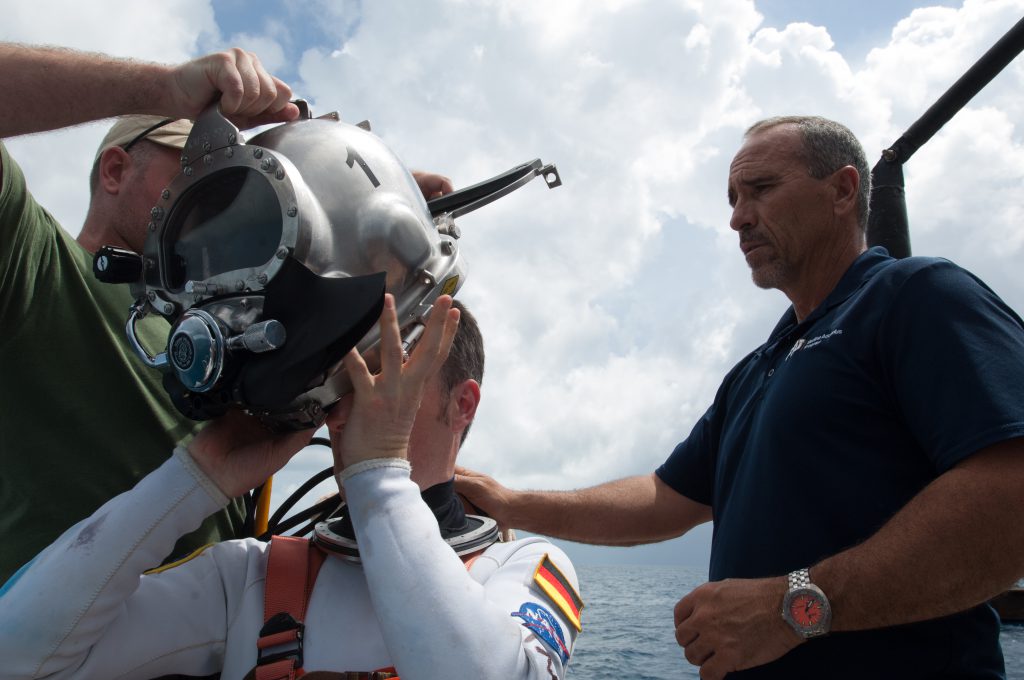
NEEMO 21 crew member Matthias Maurer donning his diving helmet with the help of diving supervisors Hank and Roger
The Kirby Morgan Stainless 37 helmet weighs 32 lbs. Each diver has a dive tender to help them put the helmet and other gear on as they prepare to dive. I won’t lie – it’s a pretty heavy helmet! However, once your head is inside of the helmet, the ability to communicate freely between your buddy and the topside crew is awesome! There are a number of safety checks that we run through as part of the pre-dive preparation, all of which ensure the system is working properly. For the past two days (training week days 3 an 4), we’ve been running through the equipment, safety checks, communication procedures, and emergency drills to ensure we are ready to dive this system comfortably.
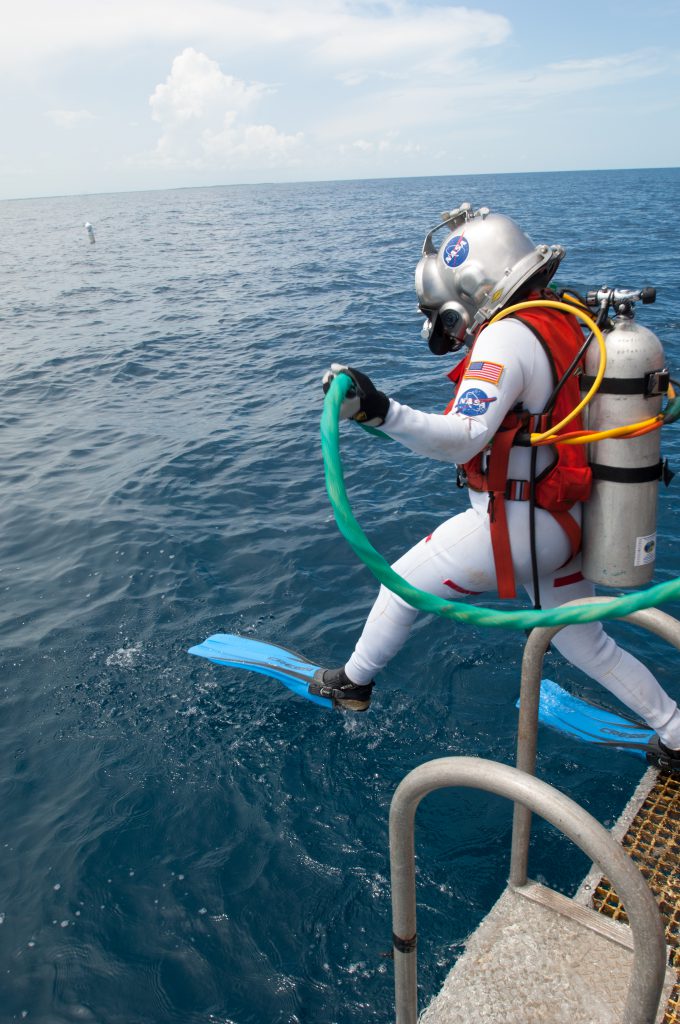
Dawn Kernagis enters the water for a training dive on the Kirby Morgan Superlite diving helmet
Day 3 encompassed safety drills and familiarization with the hard hat diving system itself. Dropping down onto the bottom, I let out a ‘Woohoo!’ over the communication system when I saw our incredible diving supervisor and instructor, Roger Garcia, on the bottom. It is such a unique feeling to have a bubble of air surrounding your head while you are underwater, allowing you to talk and breathe freely. We went through a number of drills and practiced swimming and walking on the bottom with the system – I could already tell I was going to be very happy using the helmet system!
Today, Day 4, was the day the entire crew trekked back out onto the Aquarius dive site to perform our ‘deep’ Superlite checkout dives to 65 feet. We took turns in teams of 2, with the teams on the surface supporting the team on the bottom by helping each other suit up and tending the diving umbilicals – all of which require situational awareness, teamwork, and a little bit of sweat! Speaking with astronauts Megan and Reid, the teamwork and situational awareness required is very similar to what goes on in space prior to a space EVA.
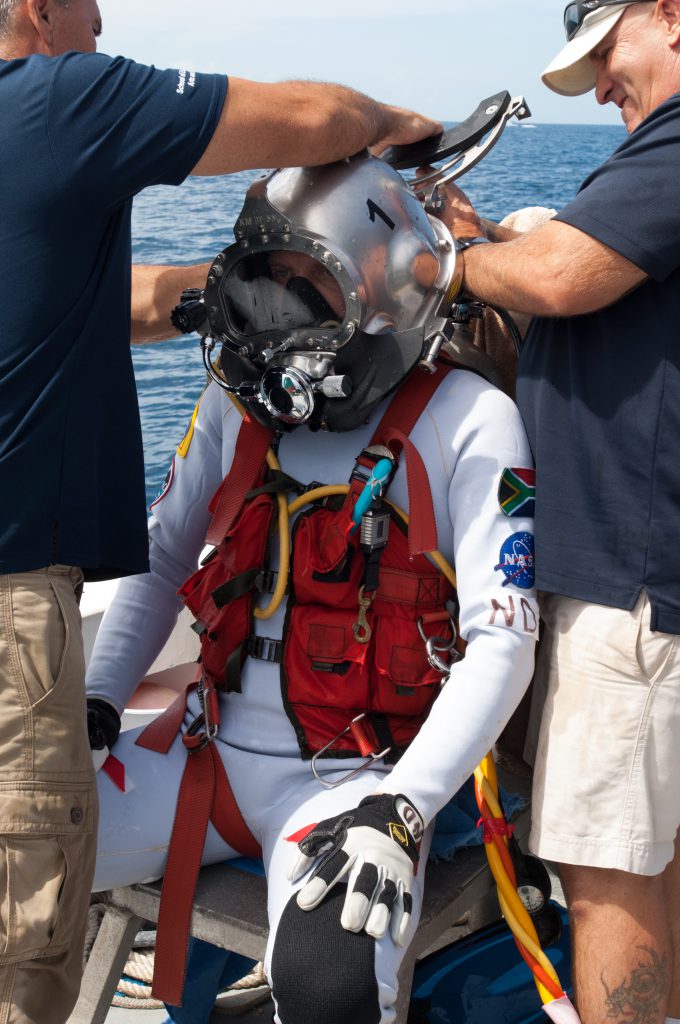
Aquanaut candidate and researcher Noel DuToit unsuiting with the help of Roger and Hank after his hard hat dive at Aquarius Reef Base
Reid and Matthias went first, followed by Megan and Marc, then Noel and I rounded out the diving day. After hearing all of the excitement from the first two teams, Noel and I dropped onto the habitat and gave each other an ecstatic fist bump. We then proceeded down to the NASA deck of the habitat to remove our fins, which allowed us to walk along the bottom as we will during the NEEMO mission. After hiking around what will soon be our underwater backyard, we checked out the underwater navigation system that we will be using during the mission. To wrap it up, we requested permission from topside to do a happy dance, which they confirmed and we performed amongst ourselves 🙂
Although neither of us wanted to leave, we knew we had a decompression obligation – which will be a different story when we perform EVA’s during saturation. For the time being, however, we knew we had a time limit to our dive and made our way back to the surface as directed by the doing supervisor. Hands down, diving the Superlite around Aquarius was one of the most incredible dives I have experienced so far!
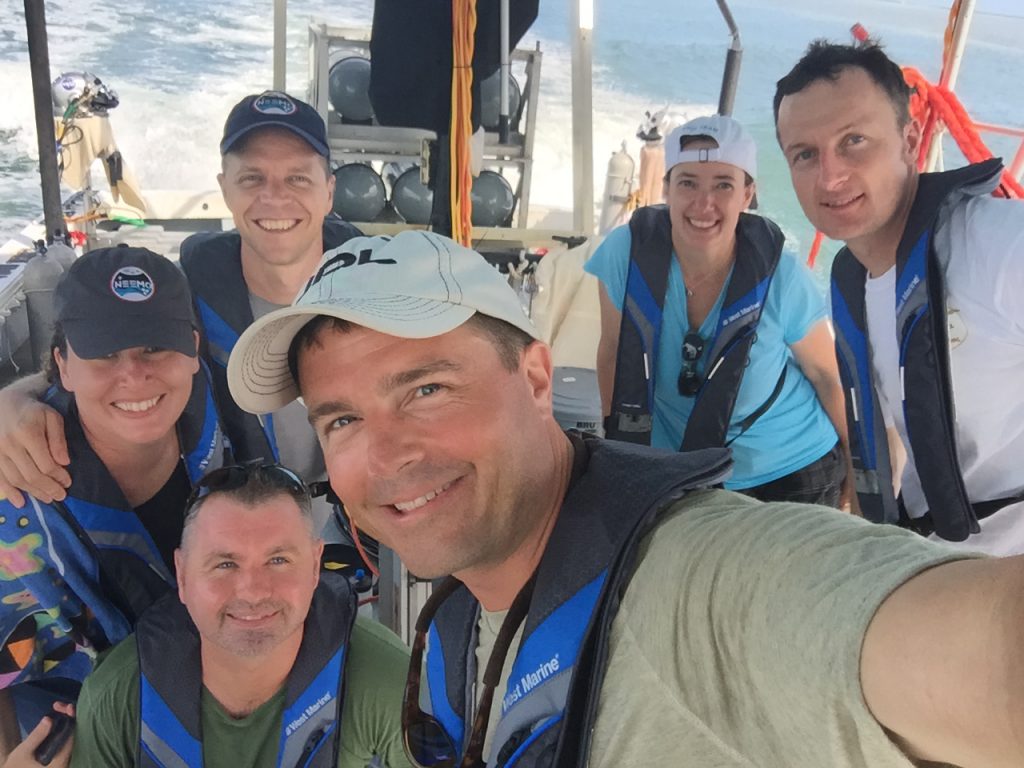
Happy NEEMO 21 Crew following our hard hat training dive to the Aquarius habitat
In addition to our Superlite training over the past two days, we have been working with the research teams to continue learning about the studies that we will be conducting throughout the mission. The European Space Agency’s Nutritional Assessment tool will be utilized to track our food intake and nutritional status throughout the mission. They are testing a new approach to nutrition tracking that will ultimately optimize astronaut food intake and health. Our crew member Noel Dutoit (Naval Postgraduate School), who is also a NEEMO 21 researcher, demonstrated his underwater xLBV300 ROV that we will be operating from the habitat in concert with the EVA divers for mission science objectives. We also reviewed the marine science projects that we will be conducting through Florida International University, which we will continue to receive hands-on training for over the next several days.
The entire crew and research teams are getting more excited each day for the mission to commence! More to follow as we wrap up crew training and prepare for Splash Down on July 18th!
For more NEEMO 21 updates, you can follow https://twitter.com/dawn_kernagis
NEEMO 21 Crew Training Begins!
Published 7.11.16
The fun begins!
During June 2016, the NEEMO 21 crew underwent their first round of crew training at Johnson Space Center. In addition to reviewing mission protocol, objectives, and safety, we specifically trained on numerous mission science objectives, including vestibular function testing, exercise equipment, medical telemetry, and learning about a variety of software and hardware that the crew will be testing throughout the mission. Next, our training moved to the Florida Keys….
On Sunday, July 10th, the NASA NEEMO 21 crew started their on-site training week at The Aquarius Reef Base (ARB) in Islamorada, Florida. The first day was comprised of FIU ‘working diver’ checkout dives and a chance to see the Aquarius habitat and surrounding landscape firsthand, supervised by Mark “Otter” Hulsbeck and Otto Rutten from FIU’s ARB. The on-water and in-water experience between these two is beyond the pale – more stories to come from these two as the mission progresses 🙂
The skills checkout involved basic SCUBA drills, from mask flooding and clearing to buddy breathing to navigation (with neutral buoyancy, of course!). While we conducted basic skills at a sandy patch near Aquarius habitat for the first dive, we did the more advanced skills at the Aquarius site for the second dive! The photos and video I have seen of the habitat don’t do it justice – the coral-covered structure stands proud against a back drop of aqua, and the marine life and colors around the entire site are stunningly vibrant. We were all grinning ear to ear as we descended upon our soon-to-be undersea home! We even had a chance to stick our heads into the ‘moon pool’, where we will be entering and exiting the habitat on a regular basis. Otter and Otto demonstrated the difficulty of whistling, and we all had a good laugh at our high-pitched voices that are a result of the higher air density before finishing up dive #2.
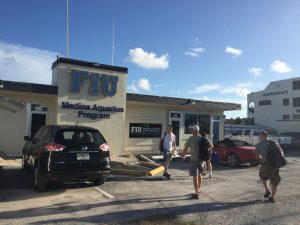
The crew arrives for their first day of training at FIU’s Aquarius Reef Base, Islamorada, Florida.
Everyone rocked their checkout dives on Day 1! We then moved in a different direction from conventional SCUBA to learn about diving with a surface supplied diving system from ARB’s Operations Director, Roger Garcia. Roger is responsible for overseeing diving operations and assuring the safety of all participants. He has a 20 year history of diving operations with the US Navy and has been with ARB since year 2003. As with all of the ARB staff, his vast experience shines as he walked us through the equipment and the safety of diving surface supplied rigs.
As a crew, we are diving the Kirby Morgan 37 SS (stainless steel) helmet when we leave the habitat to go on a simulated spacewalk. A beautiful piece of equipment that, combined with a specifically-designed umbilical assembly, will allow the crew members to have a secure gas supply alongside communication and video capabilities between the extravehicular (EV) dive crew and the intravehicular (IV) crew and surface Mission Control.
We each took the opportunity to try the helmet on, which was the first time for me! The helmet fits snug around the face, with an oral nasal mask inside of the helmet that we fit around our faces. The helmet weights 32 pounds, so you need a dive tender to help lift the helmet over your head as you are seated and geared up. As the tender lowers the helmet over your head, you pull the chin strap down and get it settled into place so you can cinch it tight once the helmet is on – this ensures that your helmet moves with your head when you turn it! The tender then locks the helmet into place using a fitted neck dam that the diver is already wearing, and you are ready to dive! We are all excited to put the helmet on again for Day 3 and try it out in the water!
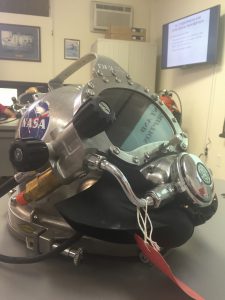
The Kirby Morgan Superlite 37 Stainless Steel diving helmet.
After learning about the mechanics of the helmet and the surface supplied system through classroom and hands-on training, we went to the dock of The ARB to check out the equipment set-up for the next several days of Superlite dive training (we also had a visit from the resident manatee!)
Following our Superlite introduction, we switched our focus to the science objectives of the mission. First up was Dr. Jason Kring’s research crew from Embry-Riddle Aeronautical University, who taught us about their optical communications study that we will be conducting during the mission. We then met with Ken Nedimyer, Director of the Coral Restoration Foundation, to get hands-on training with the equipment and protocol for the coral restoration project will be working with throughout the mission. Finally, the crew trained on equipment and protocol for sample collection and software that we will be using through the mission.
For the next three days, we will be focusing on in-water training with the Superlites and much more training on the research projects we have in store over the next several weeks. The crew, research, dive, and support staff makes up an exceptional team, and we are all beyond excited about the upcoming mission!
For more updates, follow Dawn @ https://twitter.com/dawn_kernagis
Welcome to NEEMO 21!
Published 7.6.16
This is Dawn Kernagis, IHMC Research Scientist and host of STEM-Talk, and I am absolutely thrilled and honored to join the 21st mission of NASA’s undersea analog, NEEMO (NASA Extreme Environment Mission Operations), as both a crew member and a researcher.
After completing our first round of crew training at Johnson Space Center in June, we are about to begin our second round of crew training at Aquarius Reef Base on July 10th. The NEEMO 21 Mission is slated to start with crew Splash Down on July 18th, and it all wraps up August 2nd with crew Splash Up.
Throughout the NEEMO 21 Mission, I will post frequent updates on our research, training, and what it’s like for the 6 crew members to live and work undersea in a simulated space environment.
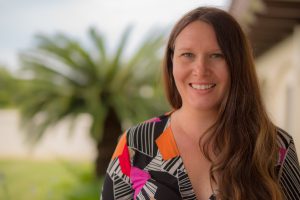
Dr. Dawn Kernagis, IHMC Research Scientist and NEEMO 21 Crew Member
About the NEEMO 21 Mission and Crew:
Living on the bottom of the Atlantic Ocean, the 21st NEEMO crew will focus on evaluating tools and techniques being tested for future space exploration by living in simulated spacecraft conditions and conducting simulated spacewalks outside of their undersea habitat. The NEEMO 21 crew and two professional habitat technicians will live 62 feet (19 meters) below the surface of the Atlantic Ocean at the The Aquarius Undersea Reef Base, owned and operated by Florida International University under permit by NOAA and the Florida Keys National Marine Sanctuary.
Inside the habitat, the international crew will conduct a variety of research and operational studies, such testing a mini DNA sequencer and a medical telemetry device that will be used for future space applications. During their simulated spacewalks, the crew will collect samples for marine biology and geology studies, team with underwater remote operating vehicles, test operational software, and participate in a coral restoration project. Throughout many of these tasks, the mission will also test time delays in communications to simulate scenarios often encountered in space exploration.
NASA astronaut Reid Wiseman will command the first 8 days of the NEEMO 21 mission aboard the Aquarius laboratory. Wiseman flew in space as part of Expedition 40/41 in 2014, spending 166 days living and working in the extreme environment of microgravity aboard the International Space Station. Wiseman was a naval aviator and test pilot prior to joining NASA in 2009.
NASA astronaut Megan McArthur Behnken will command the second half of NEEMO 21 and will live in the habitat for the entire 16-day mission. Behnken has served as a Capsule Communicator for both the space shuttle and space station, and she flew on the STS-125 shuttle mission in 2009. Prior to joining NASA, Behnken obtained her PhD in Oceanography at Scripps Institution of Oceanography.
Joining Behnken for the entire 16 days is Matthias Maurer (European Space Agency). For the first 8 days, Dr. Marc O’Griofa (Veterans Administration researcher) will also join Wiseman, Behnken, and Maurer. For the second half of the mission, Behnken and Maurer will be joined by Dr. Dawn Kernagis (IHMC researcher) and Dr. Noel Du Toit (Naval Postgraduate School researcher).

